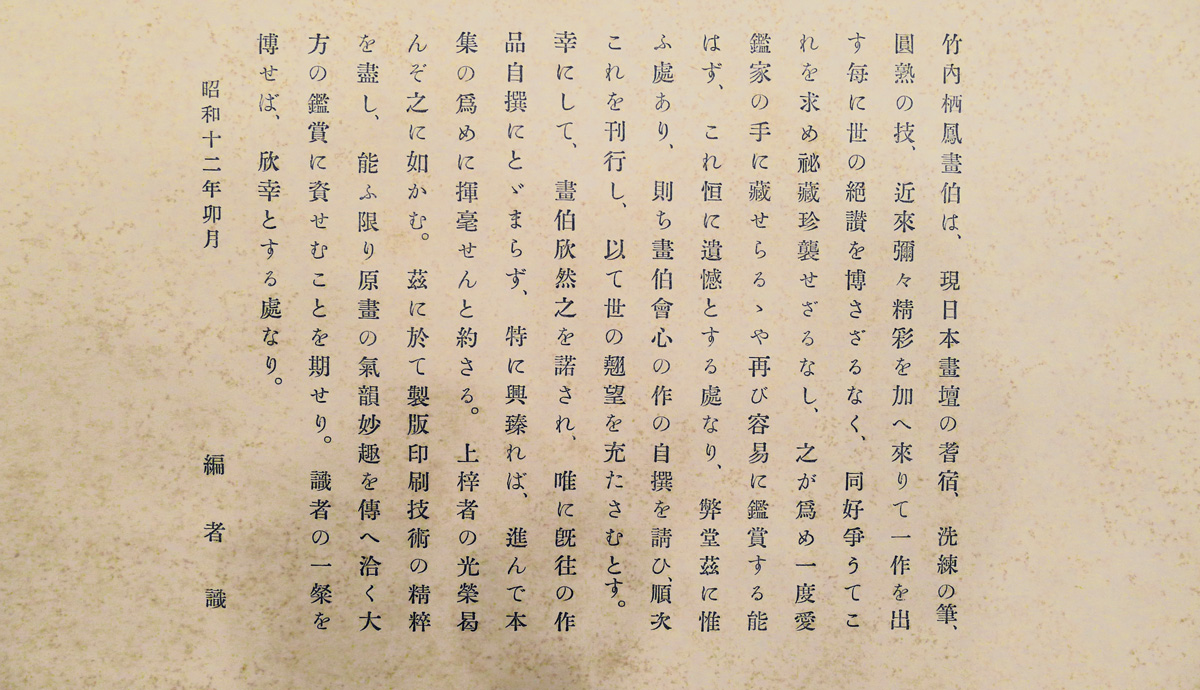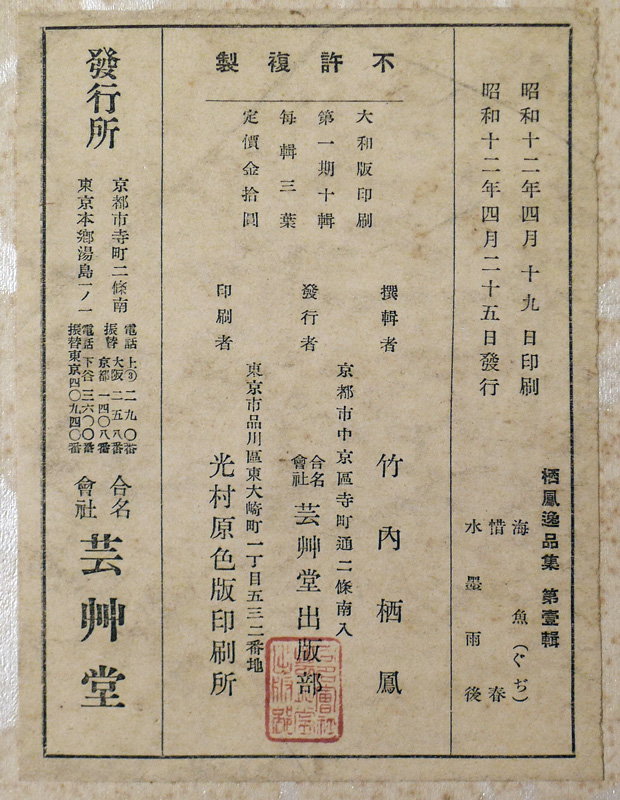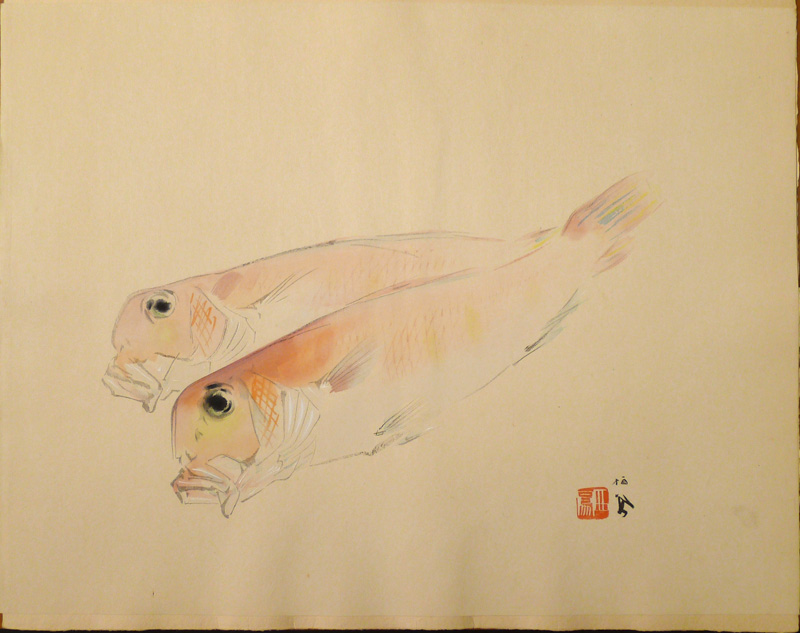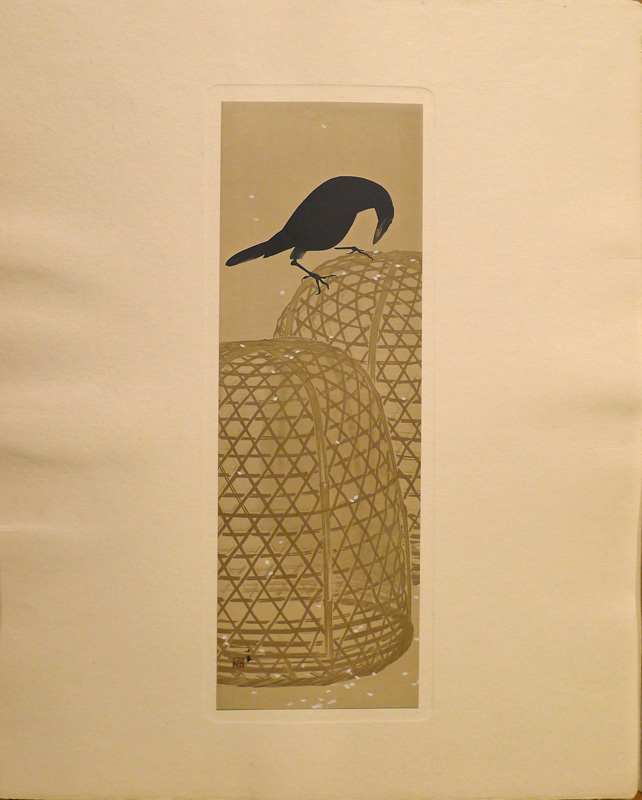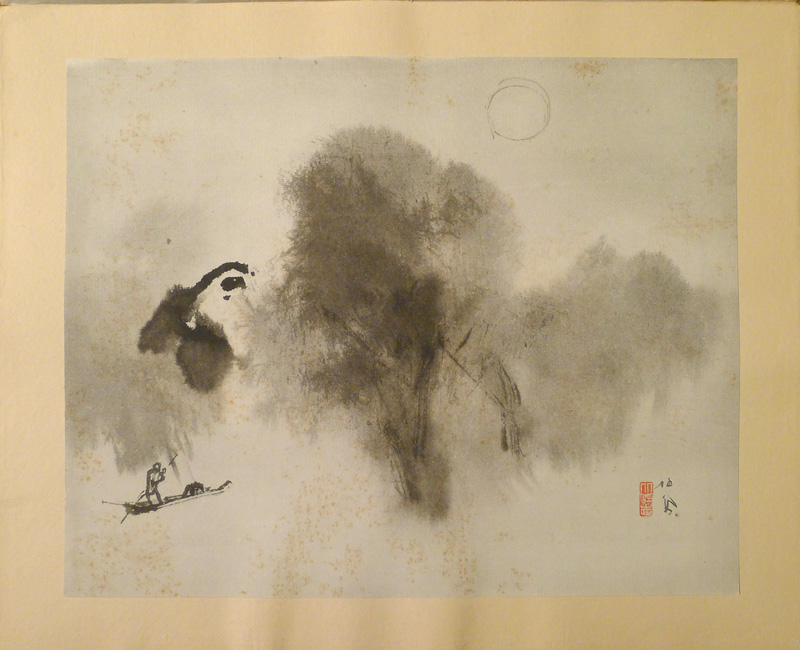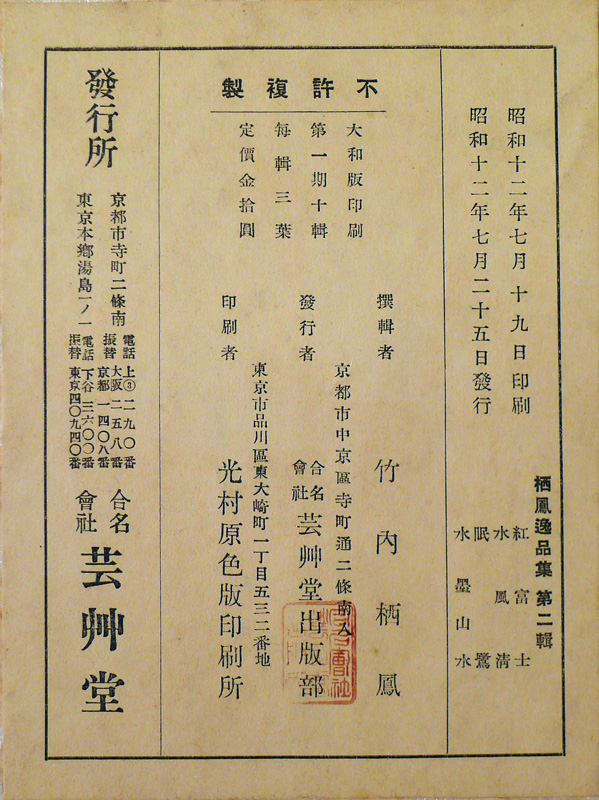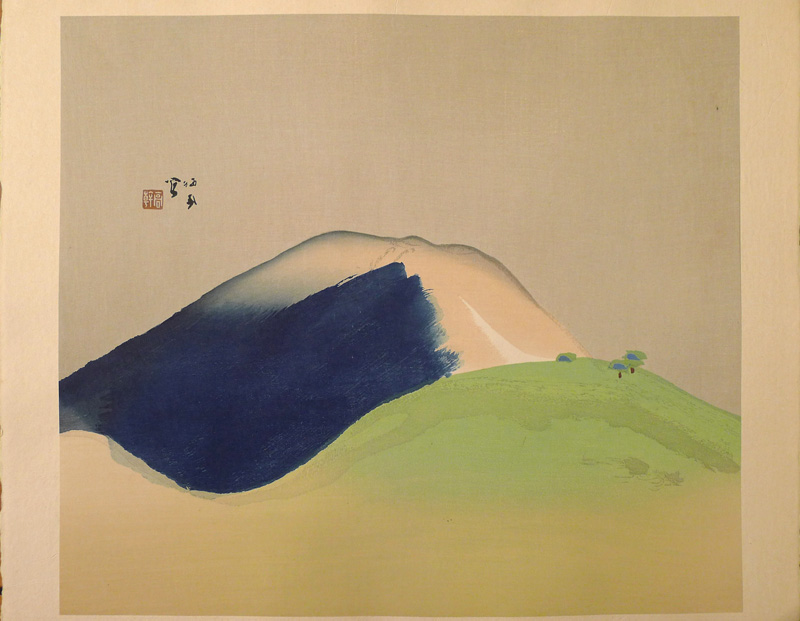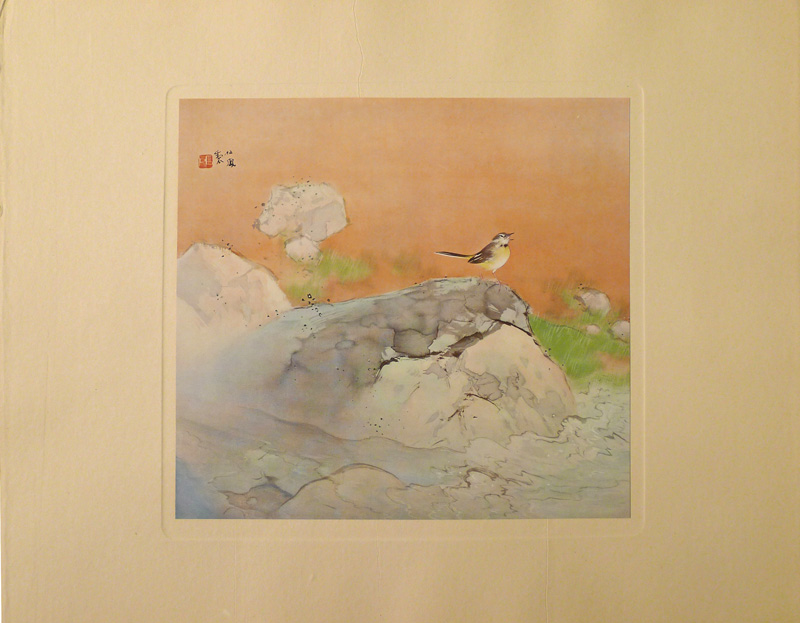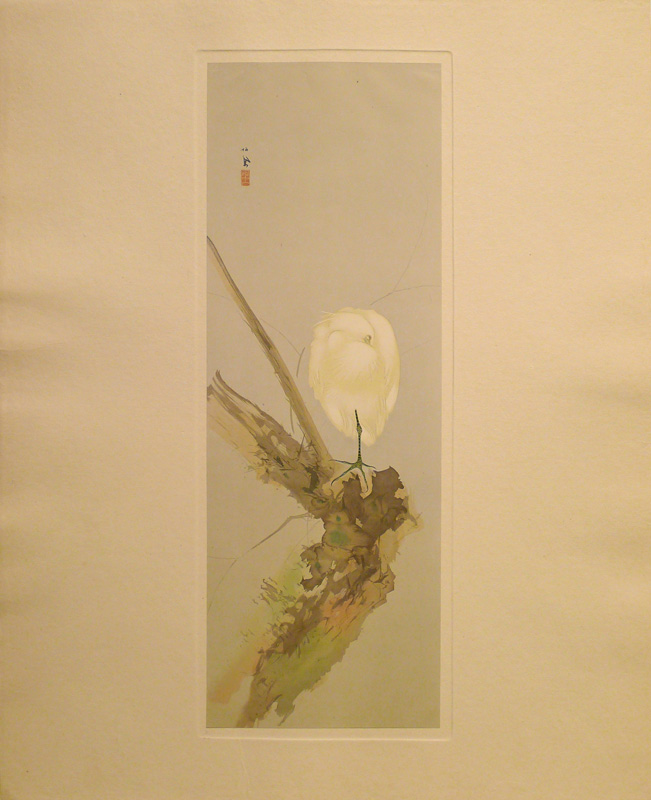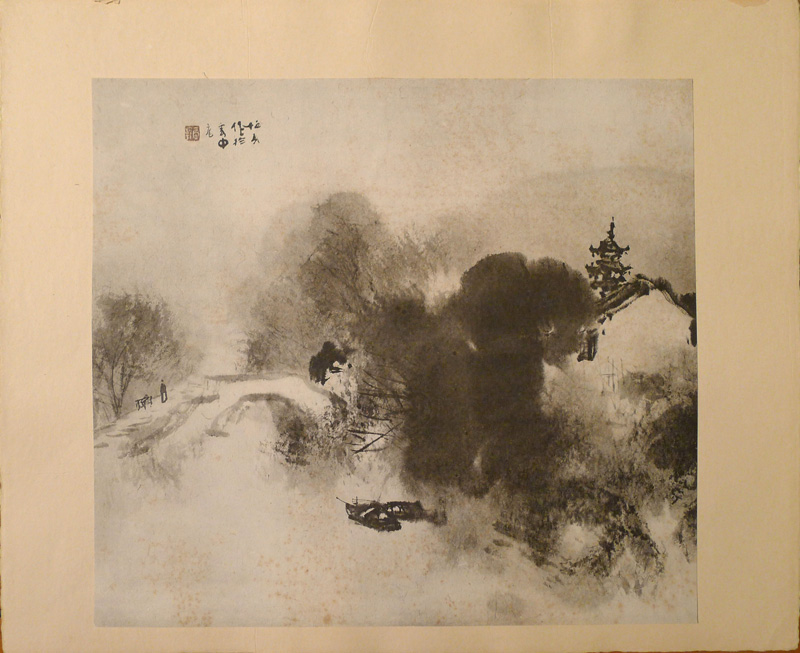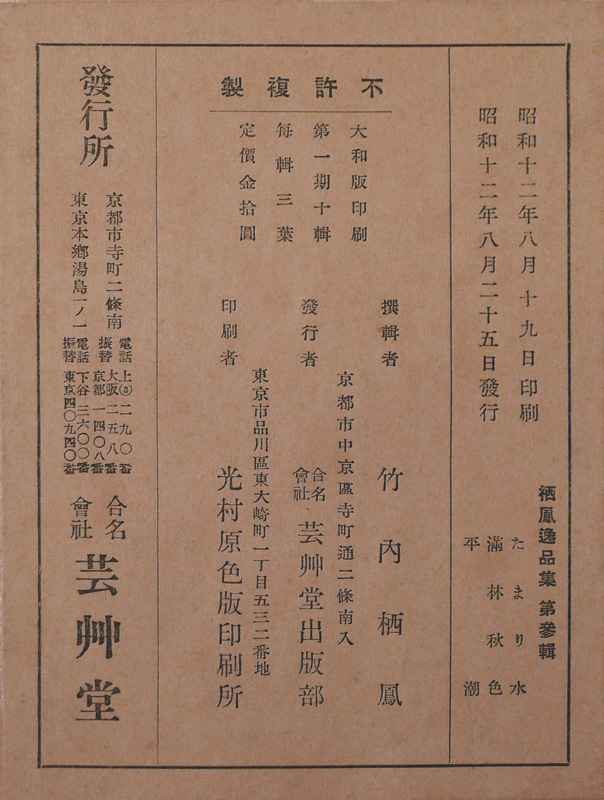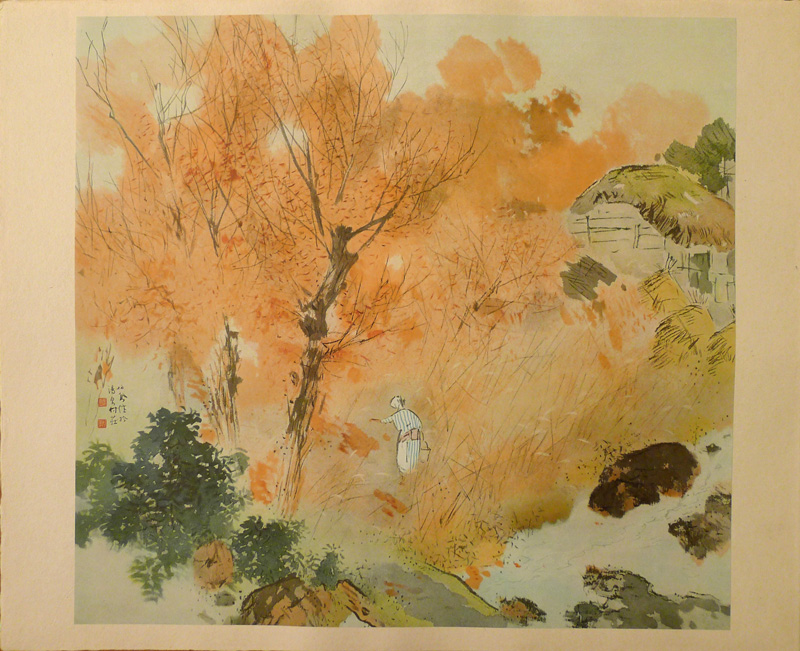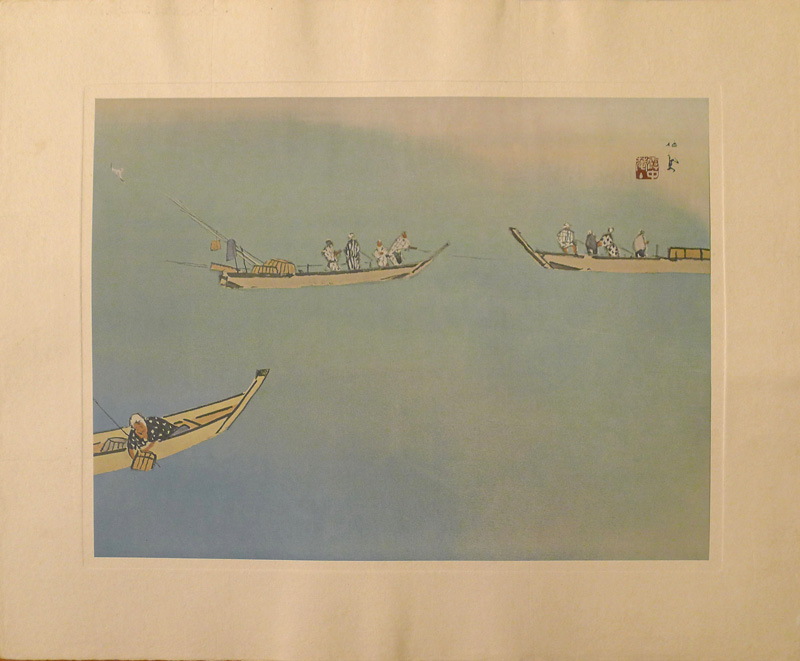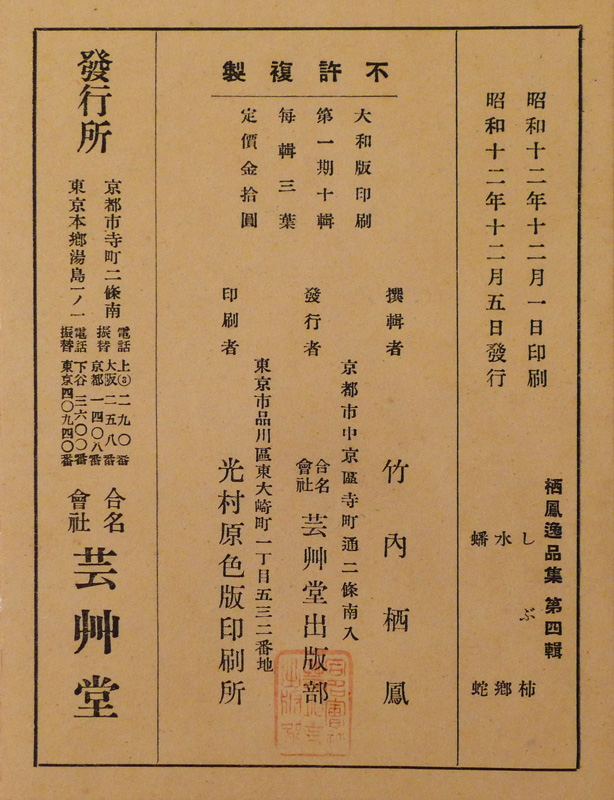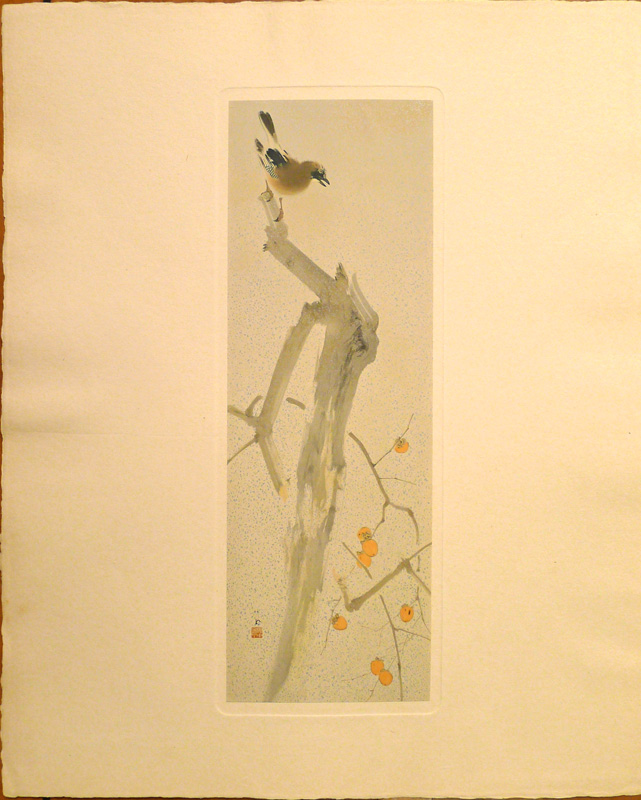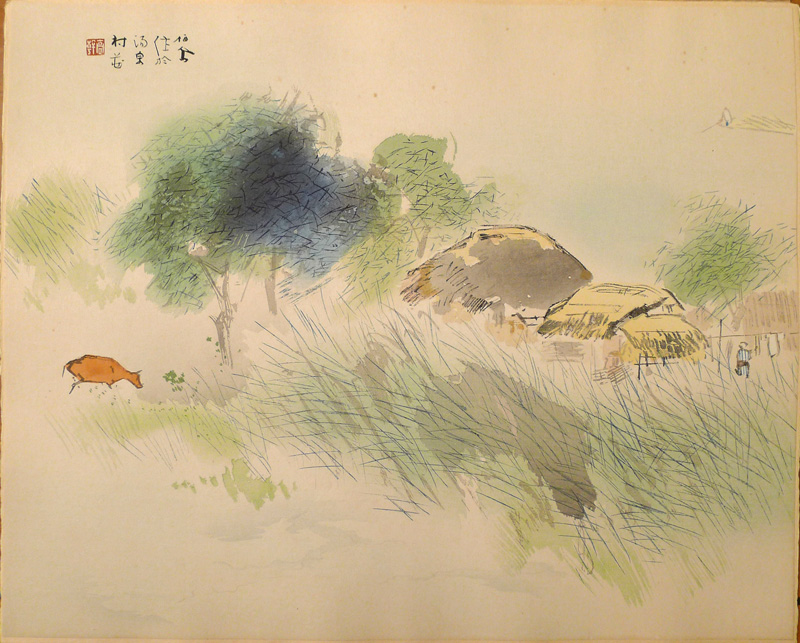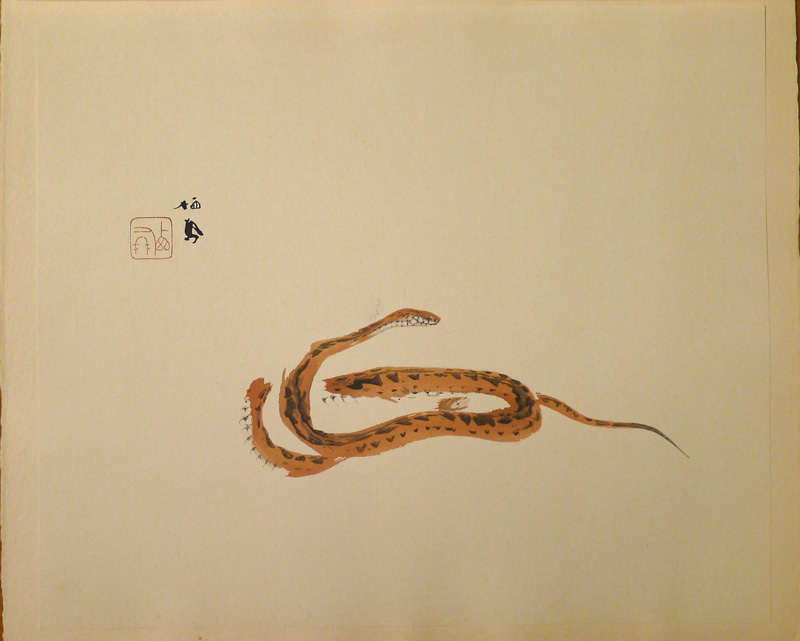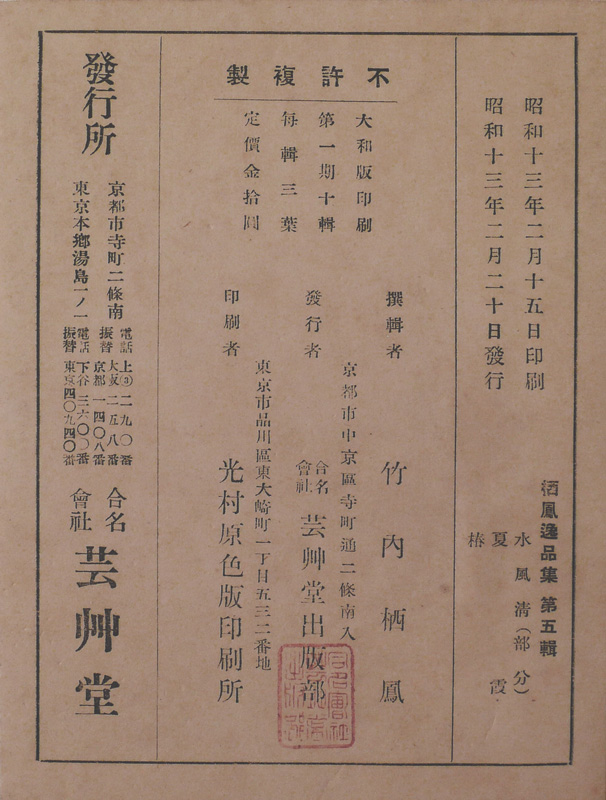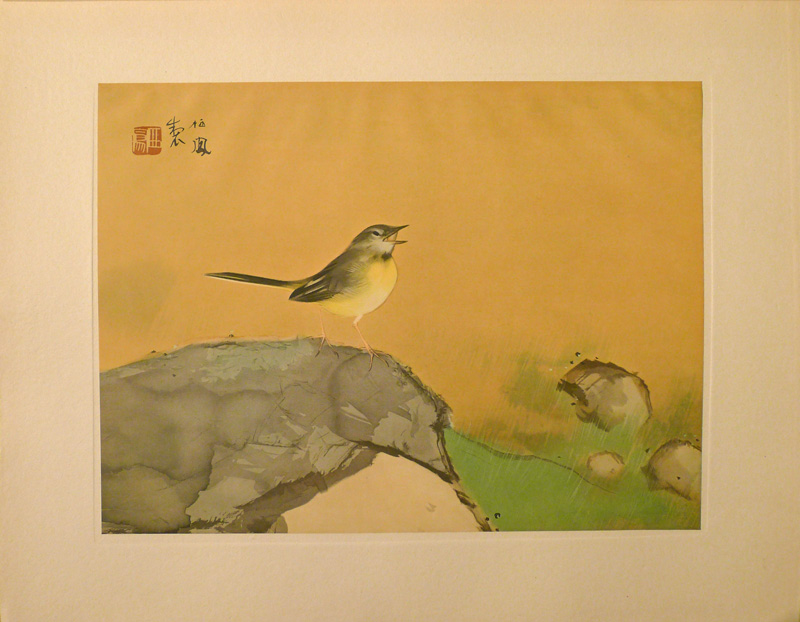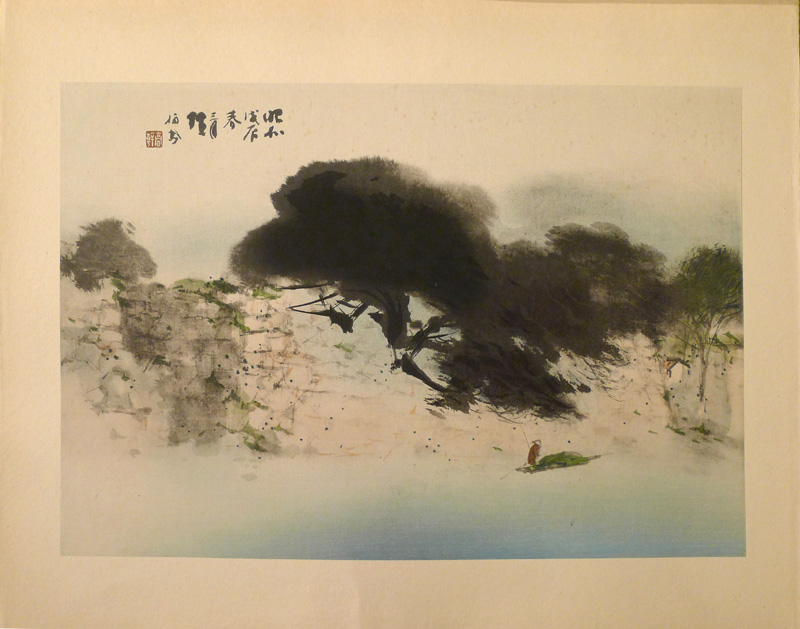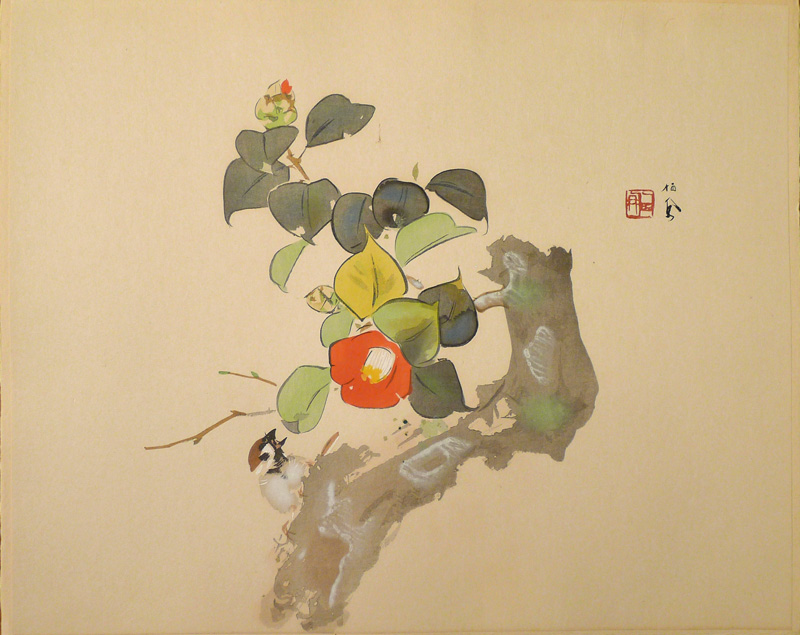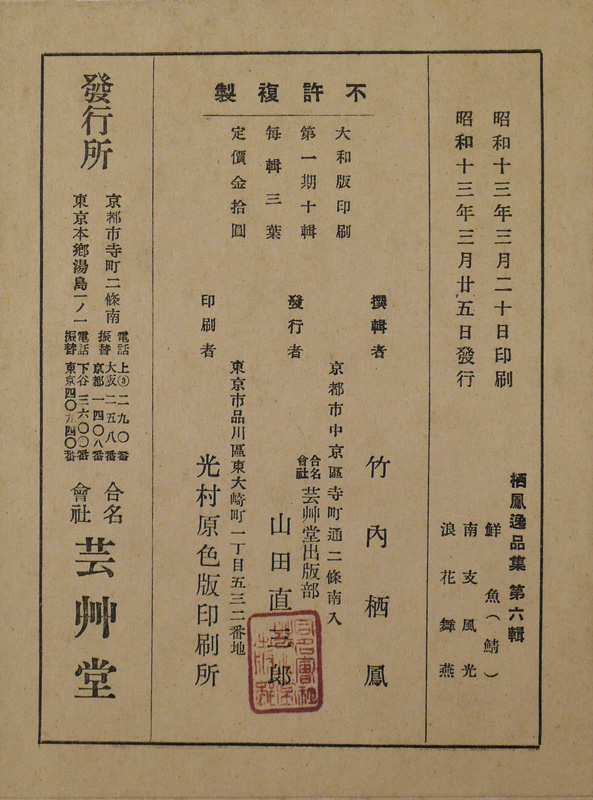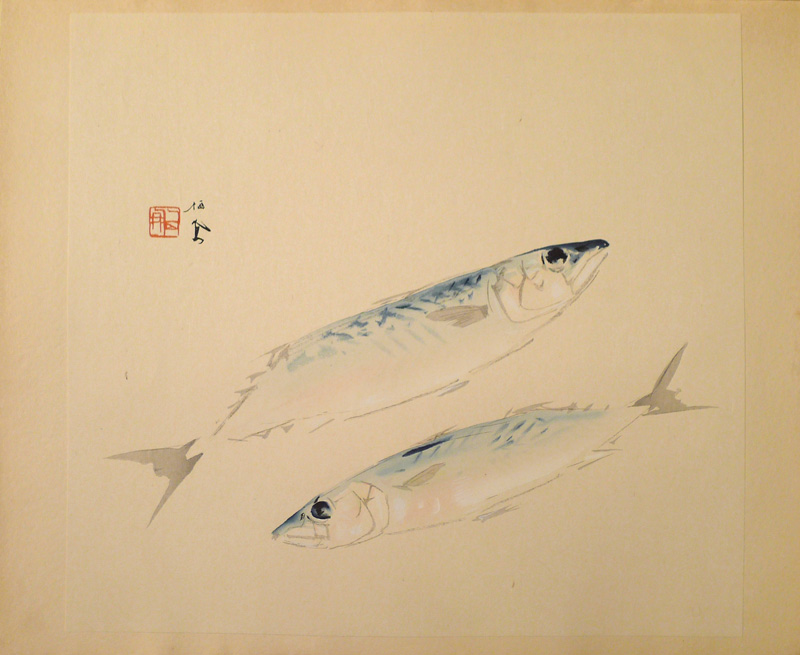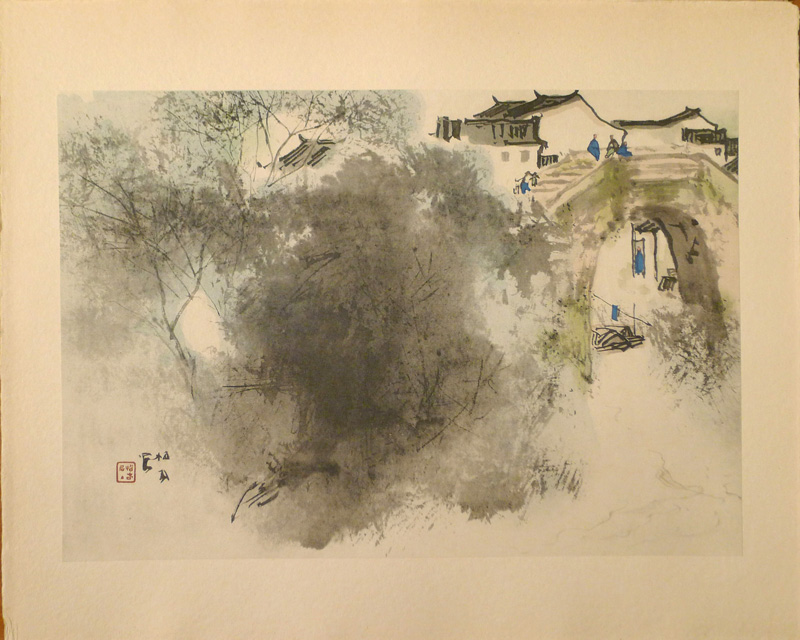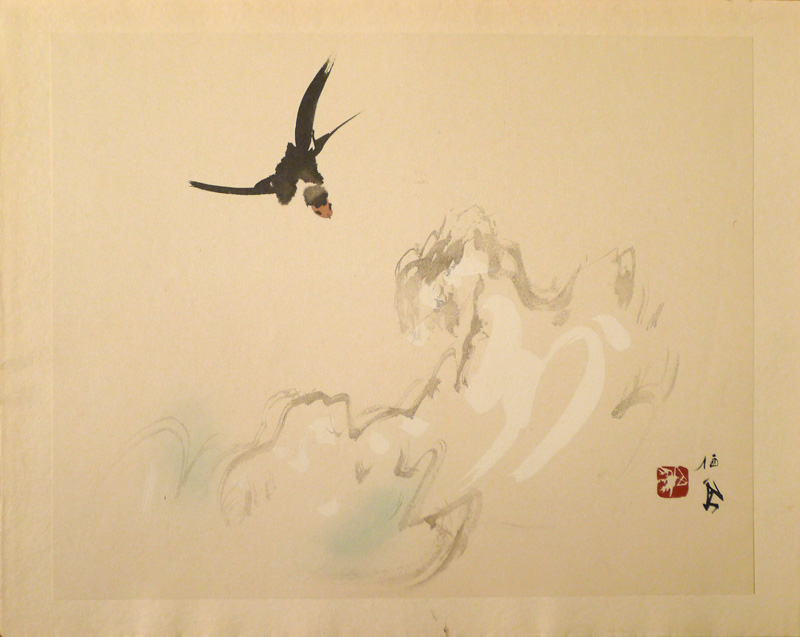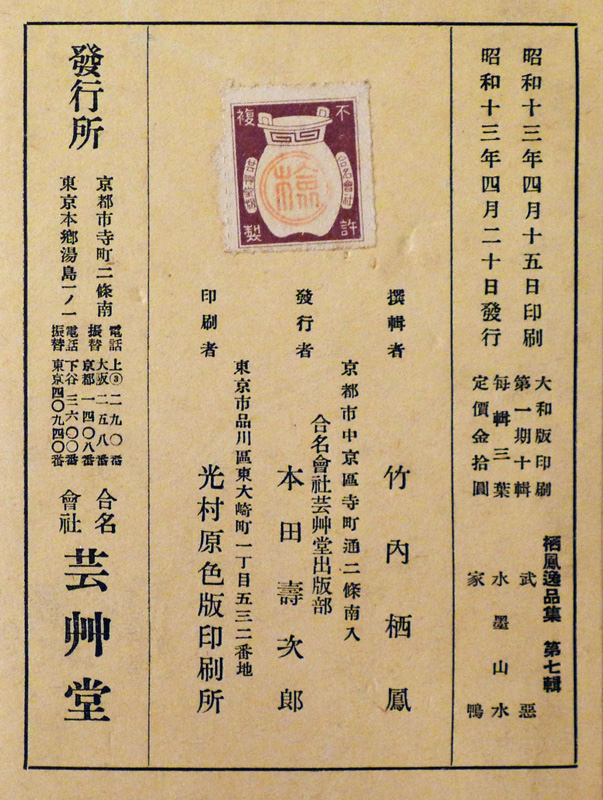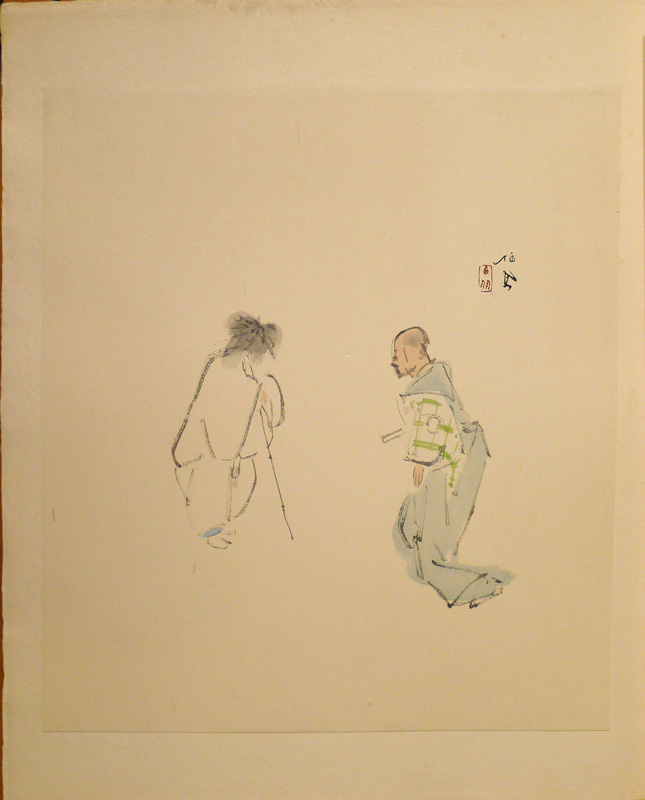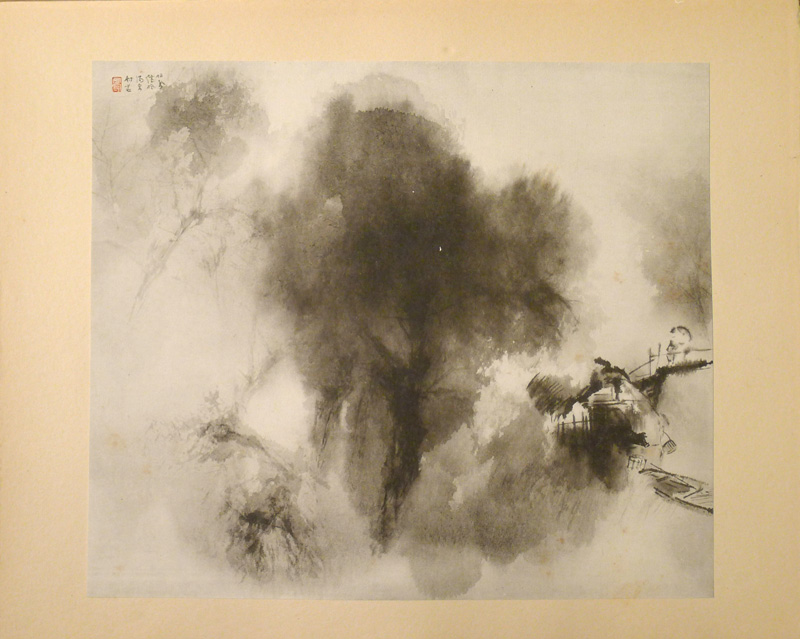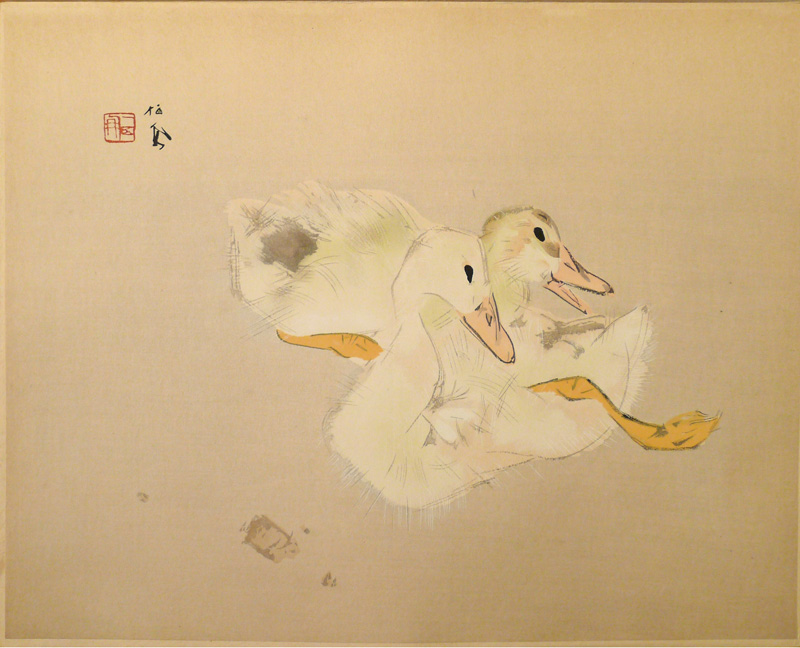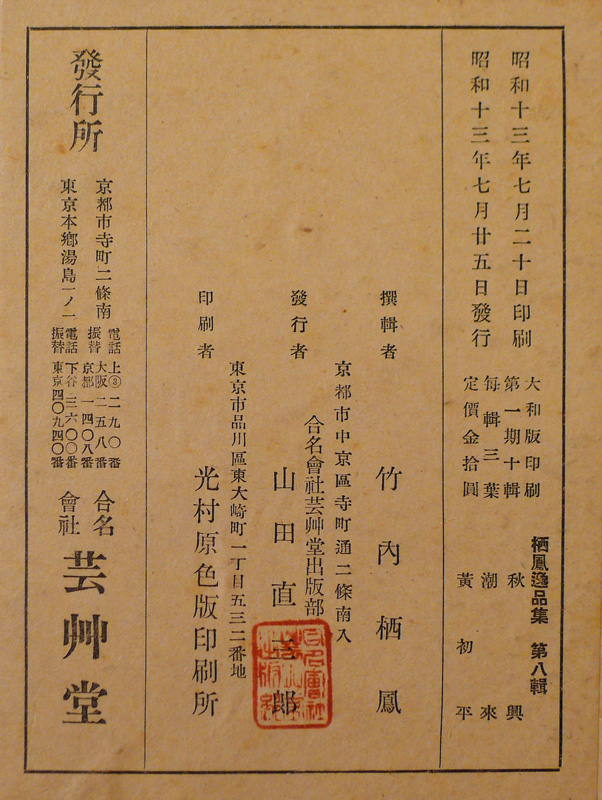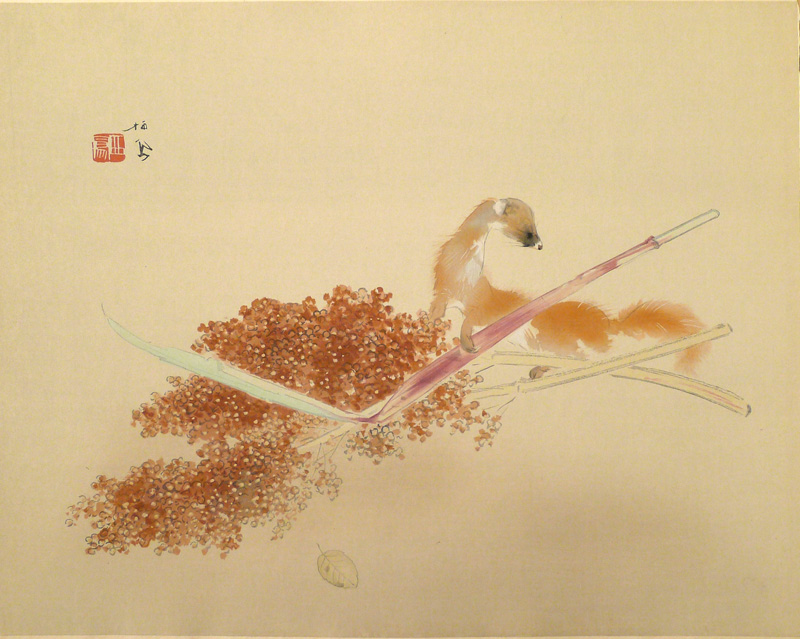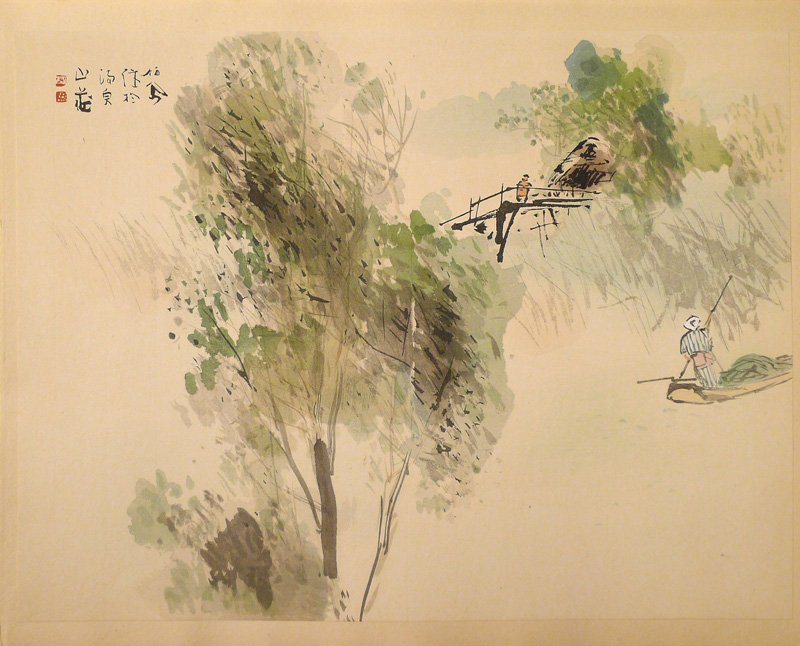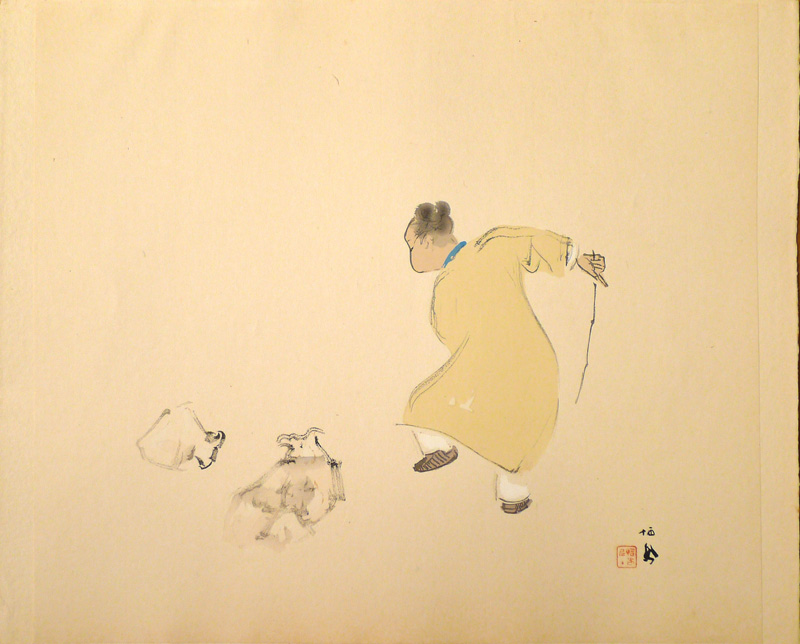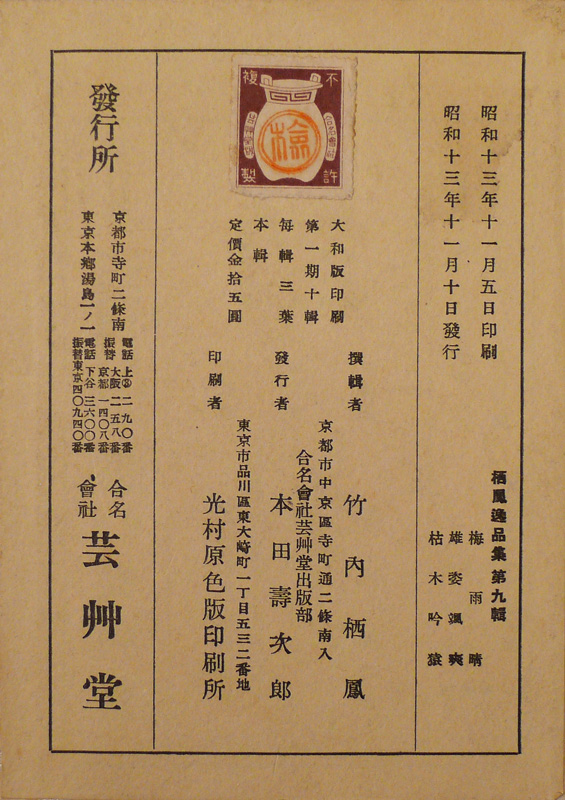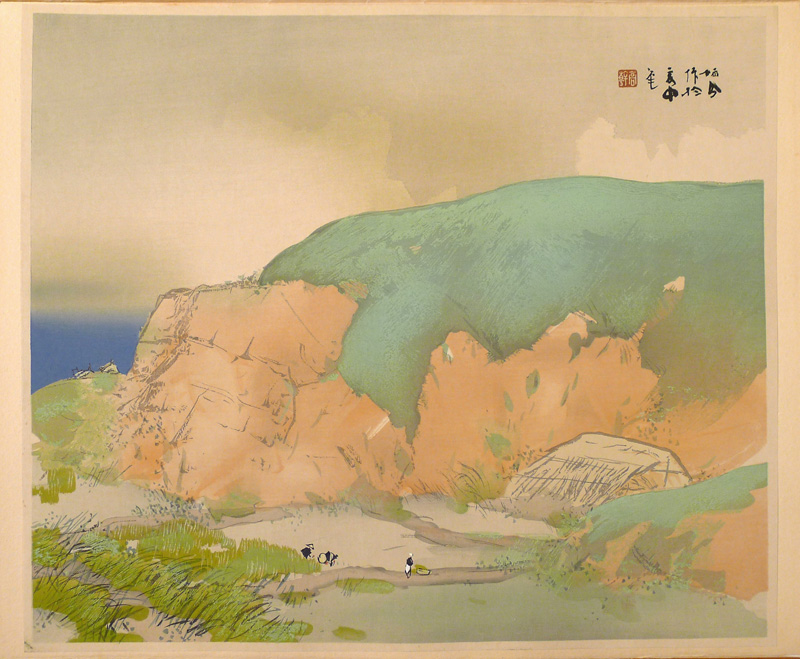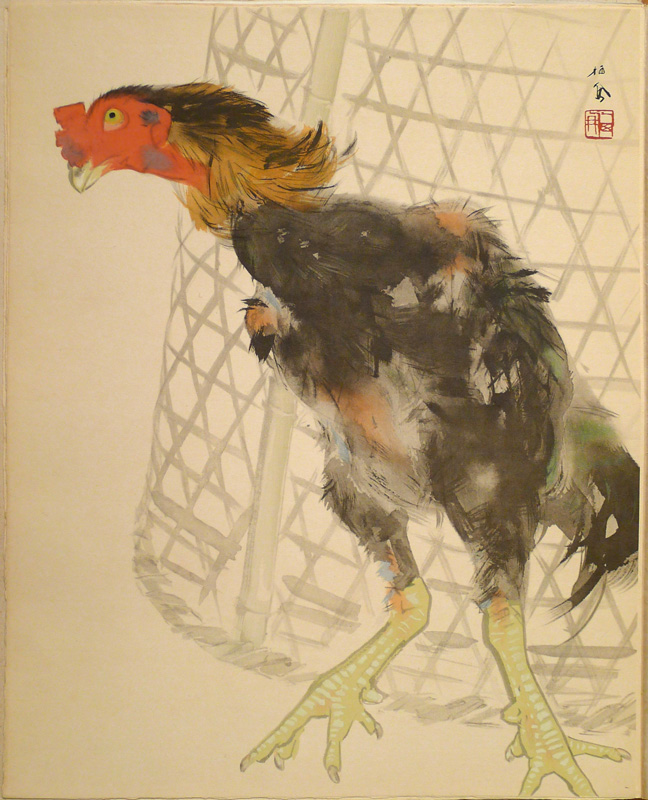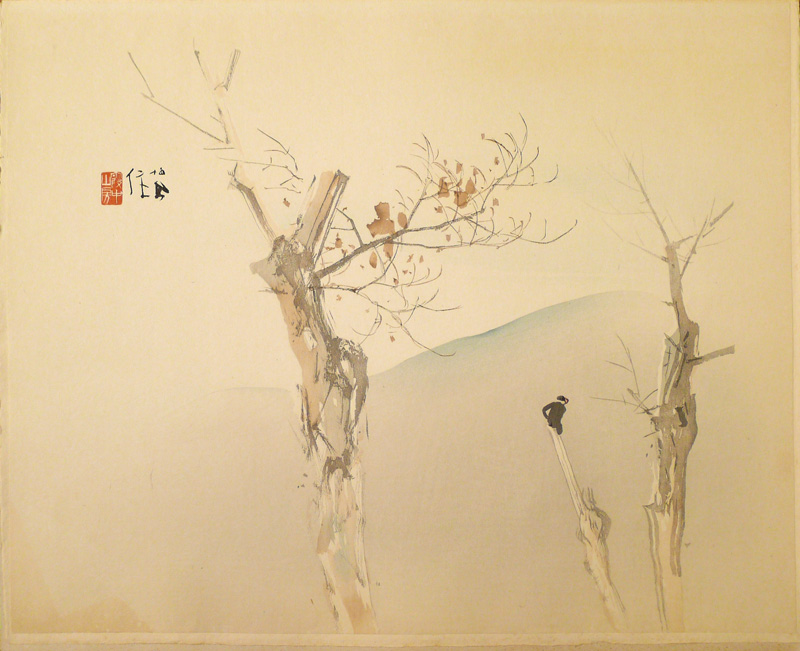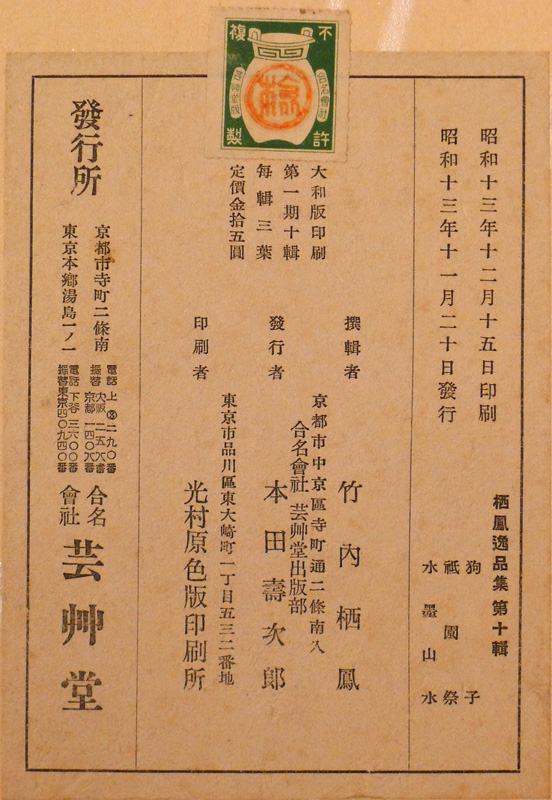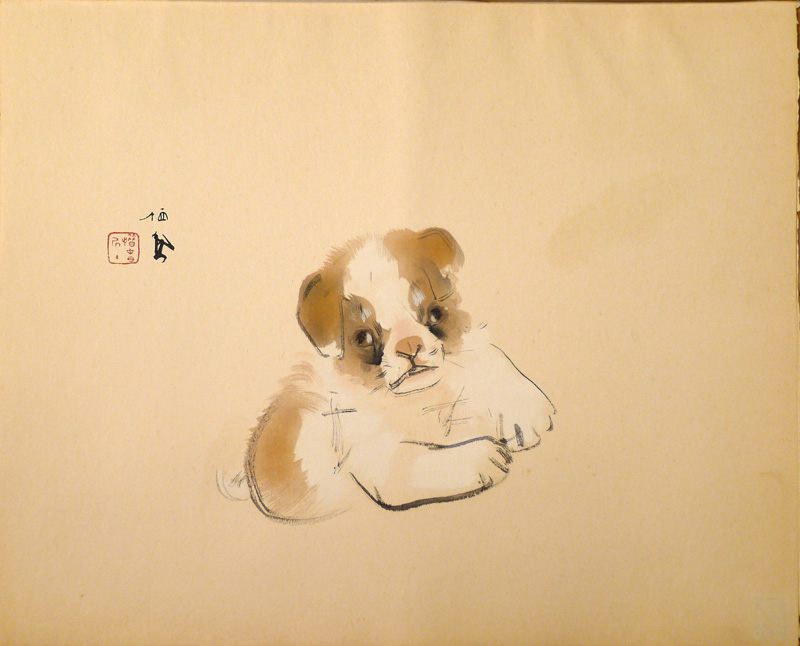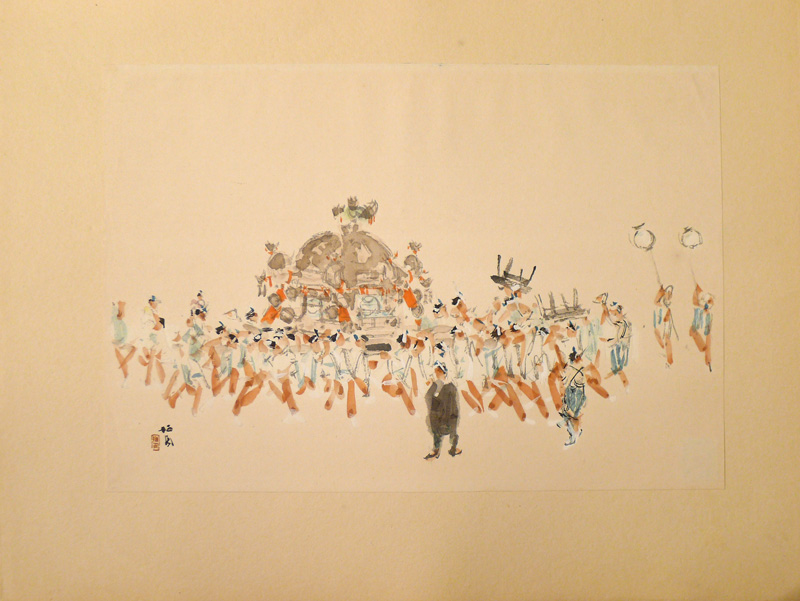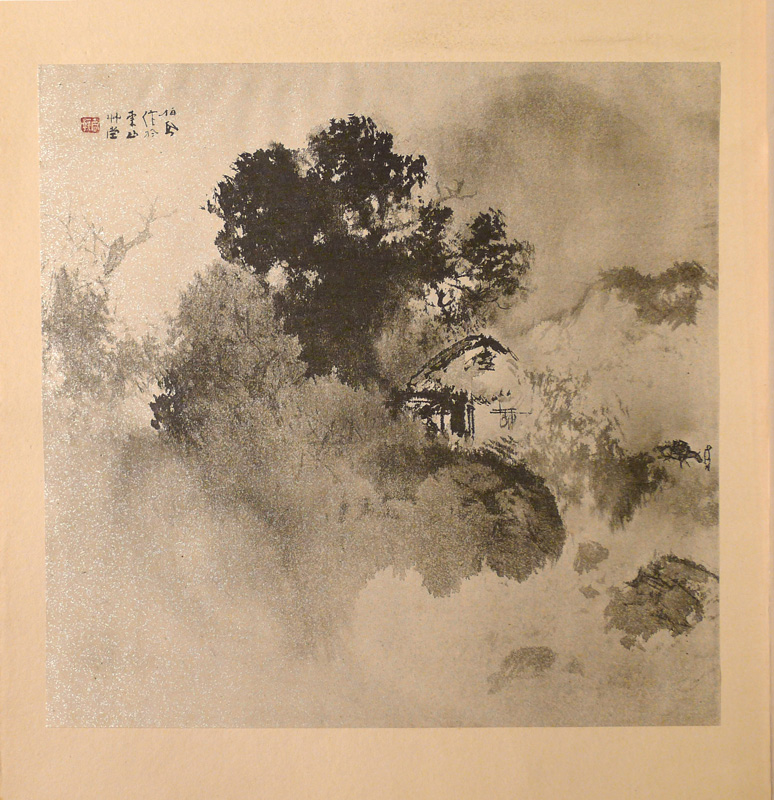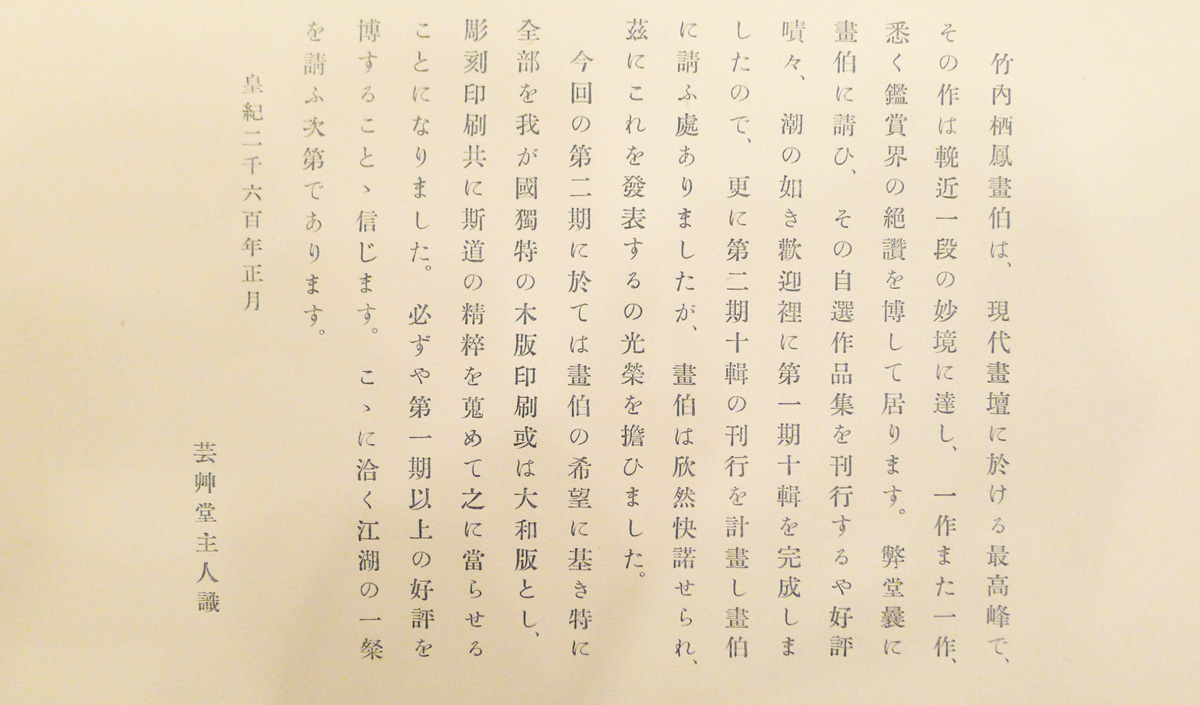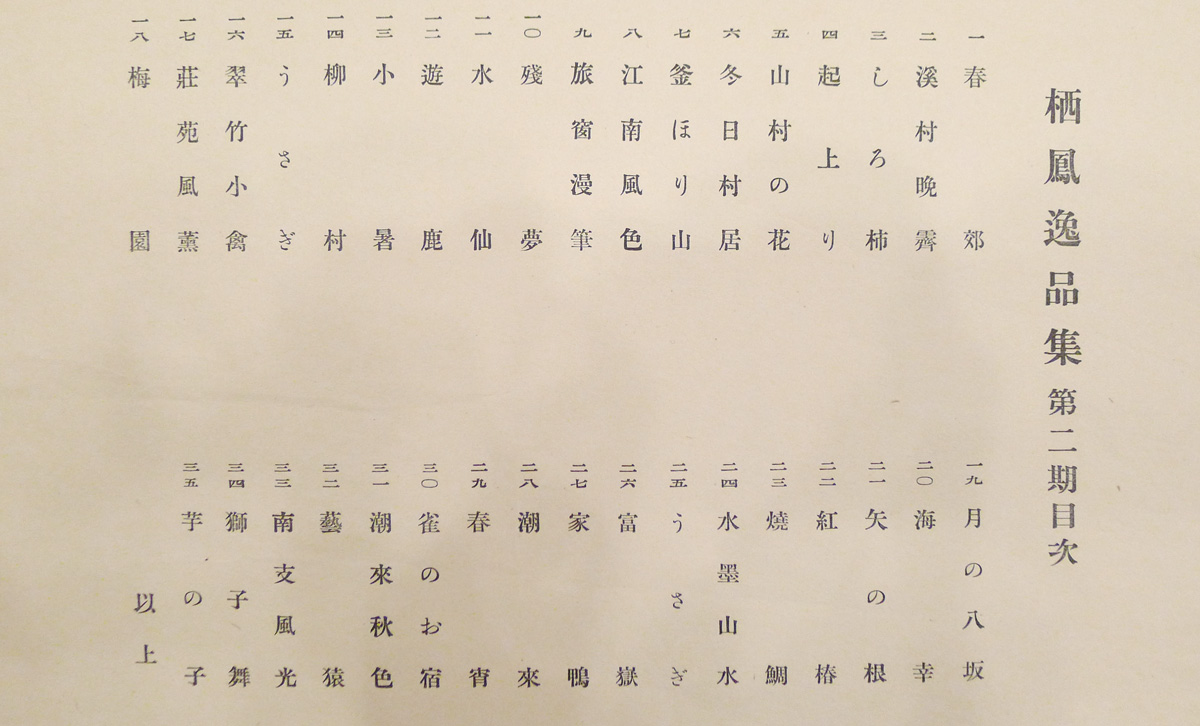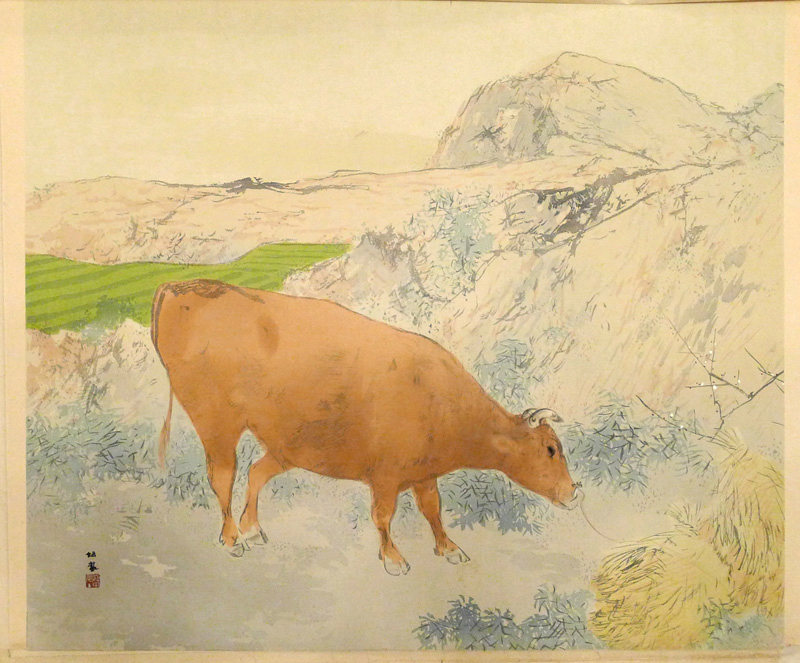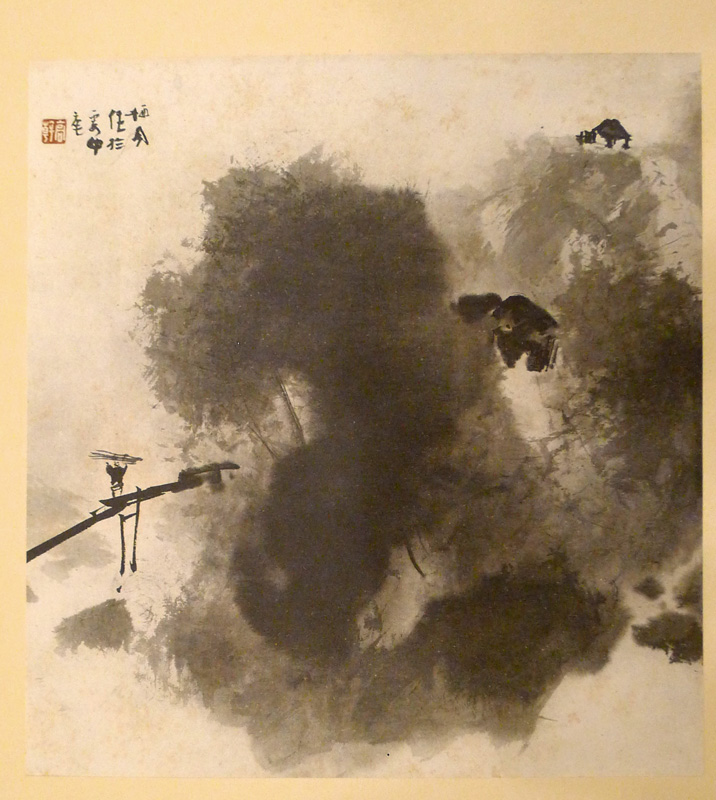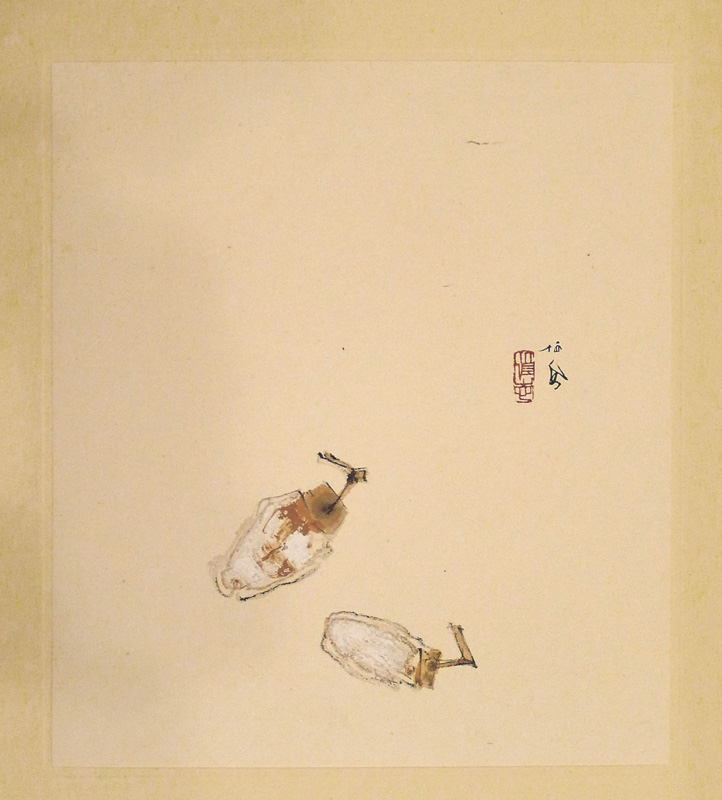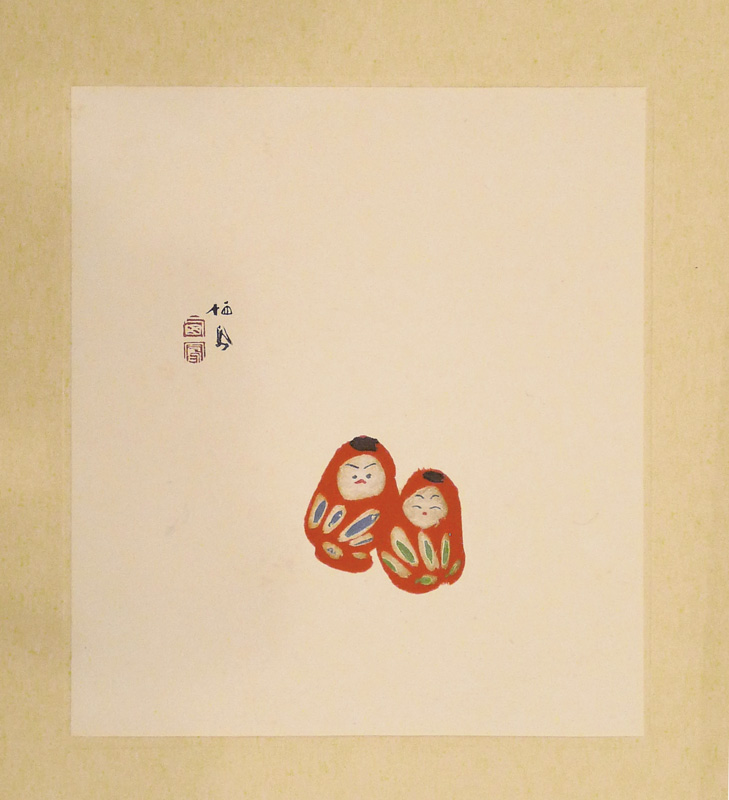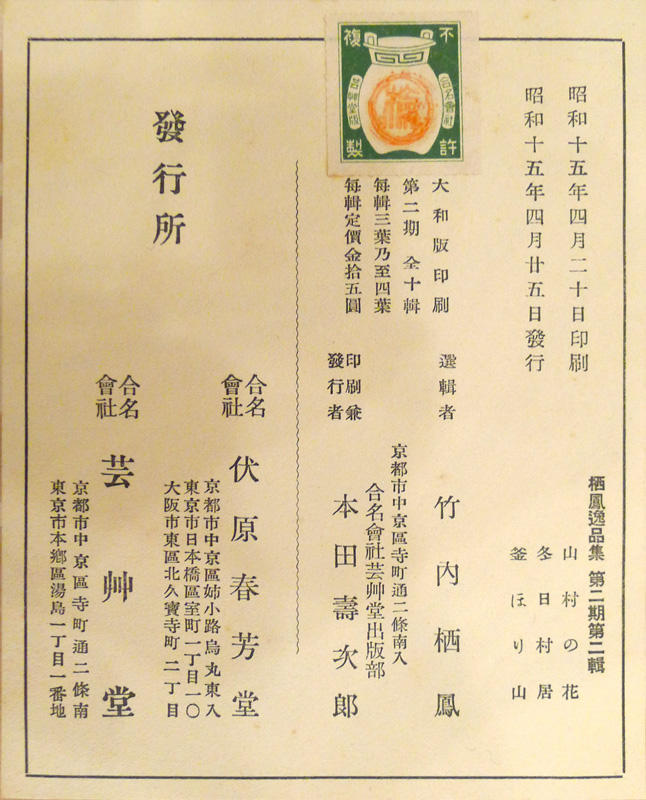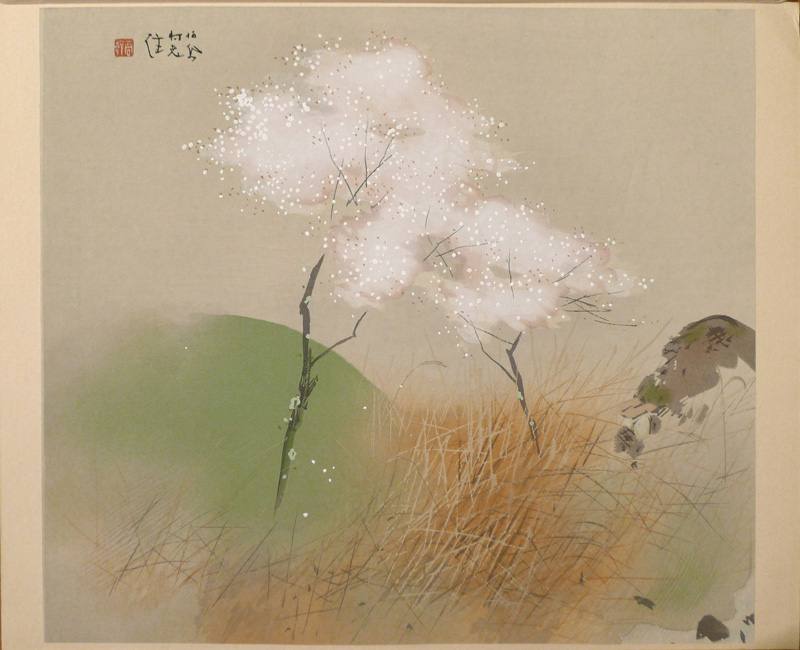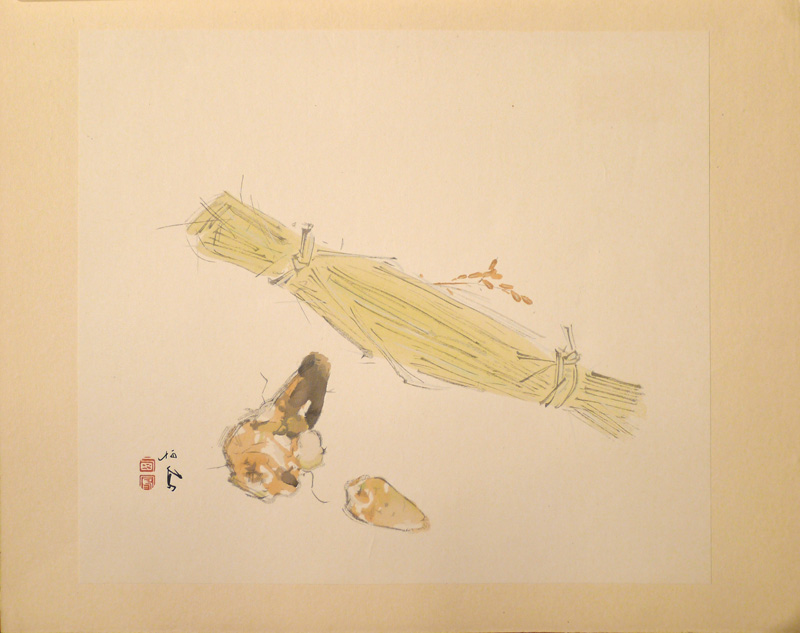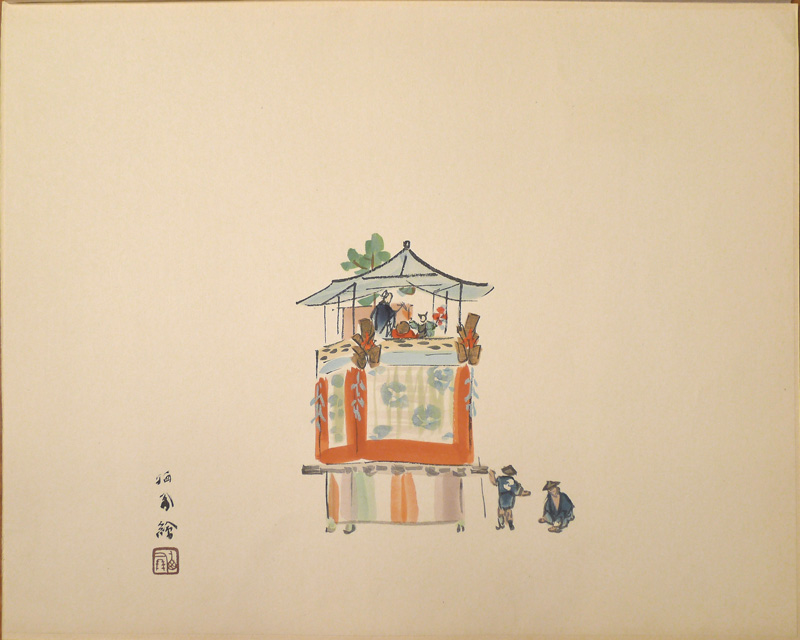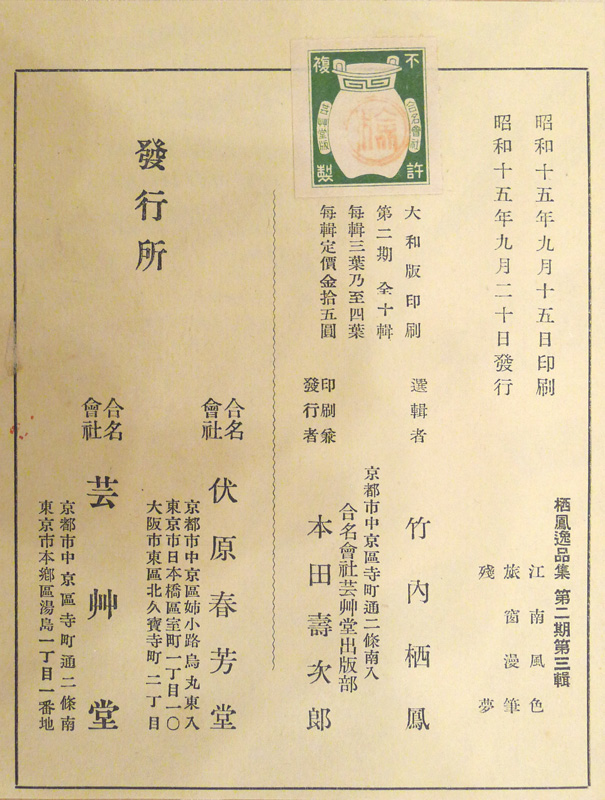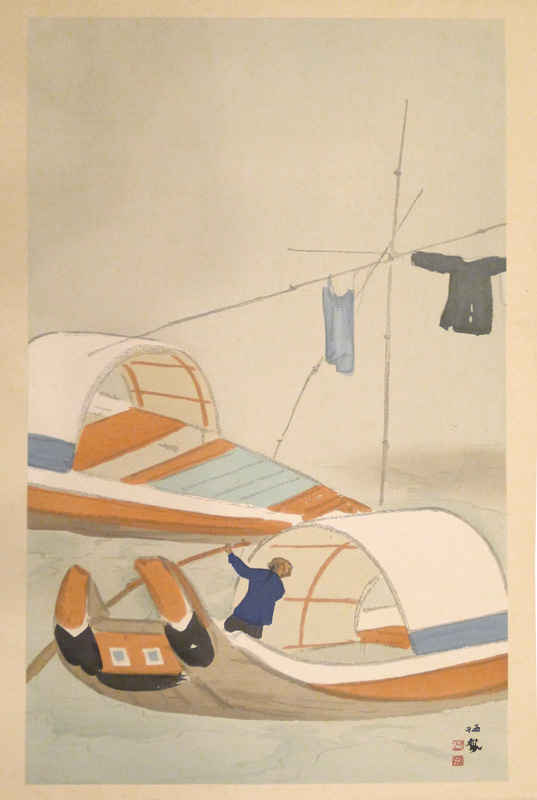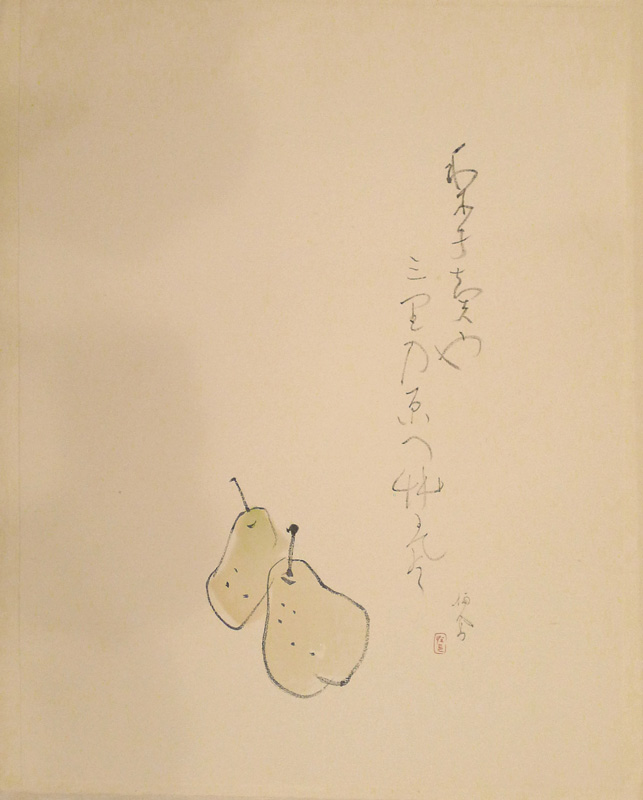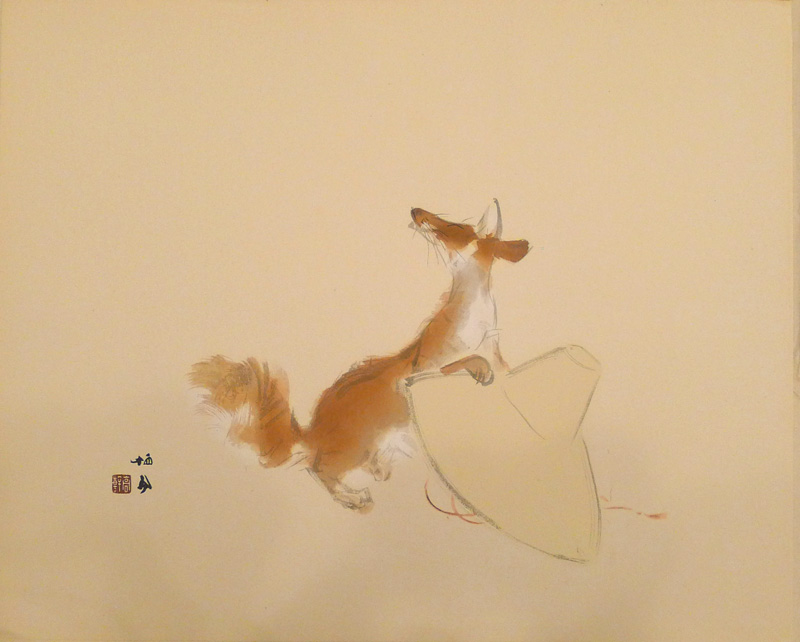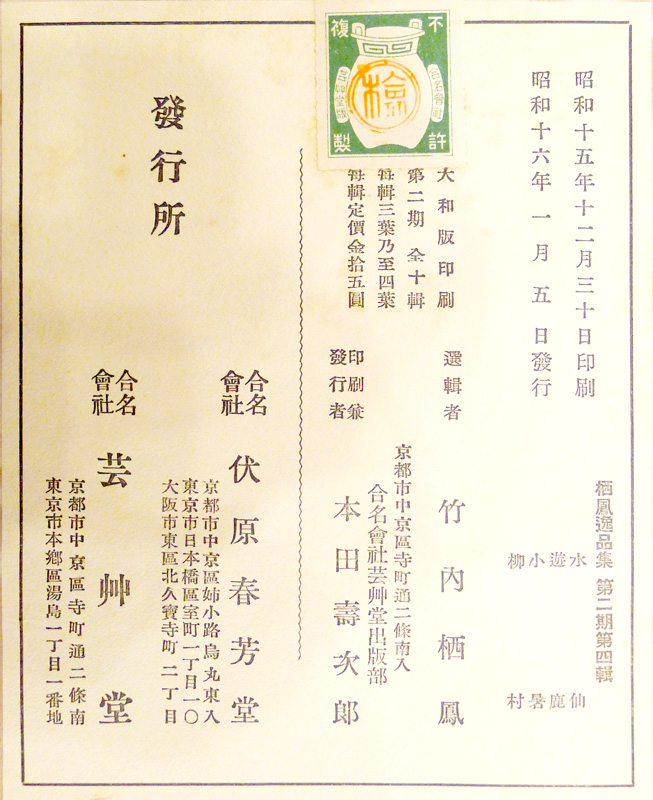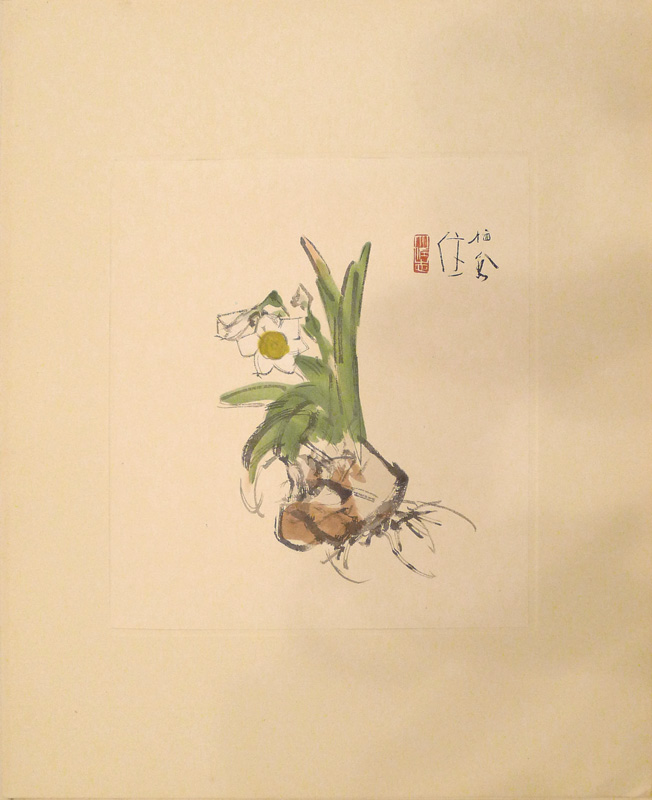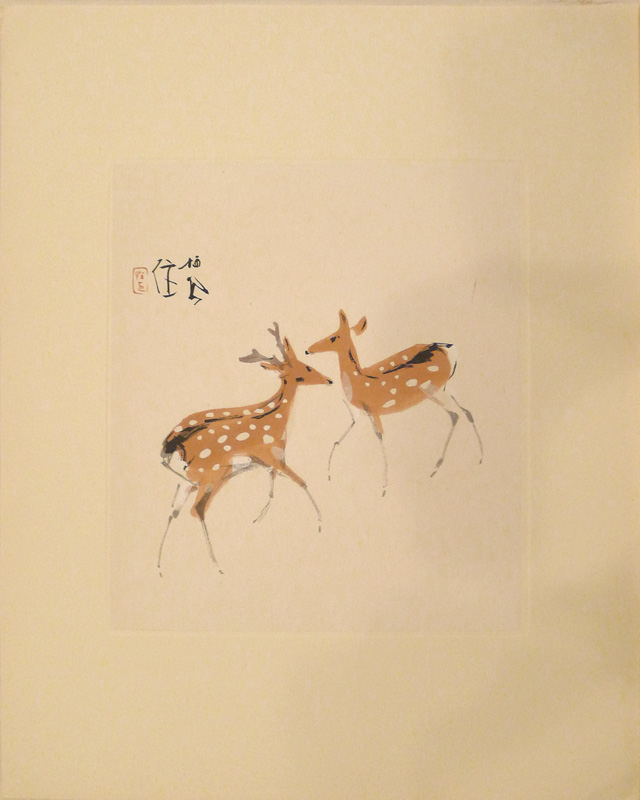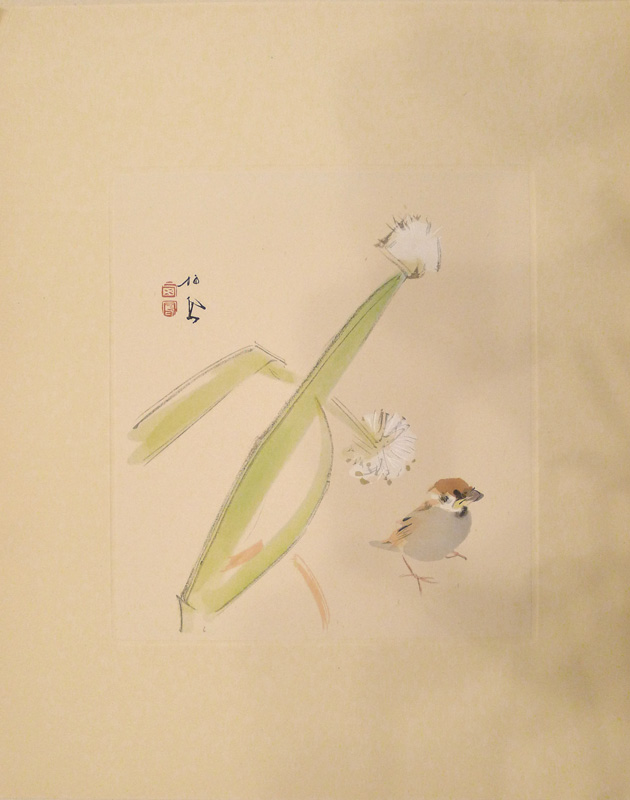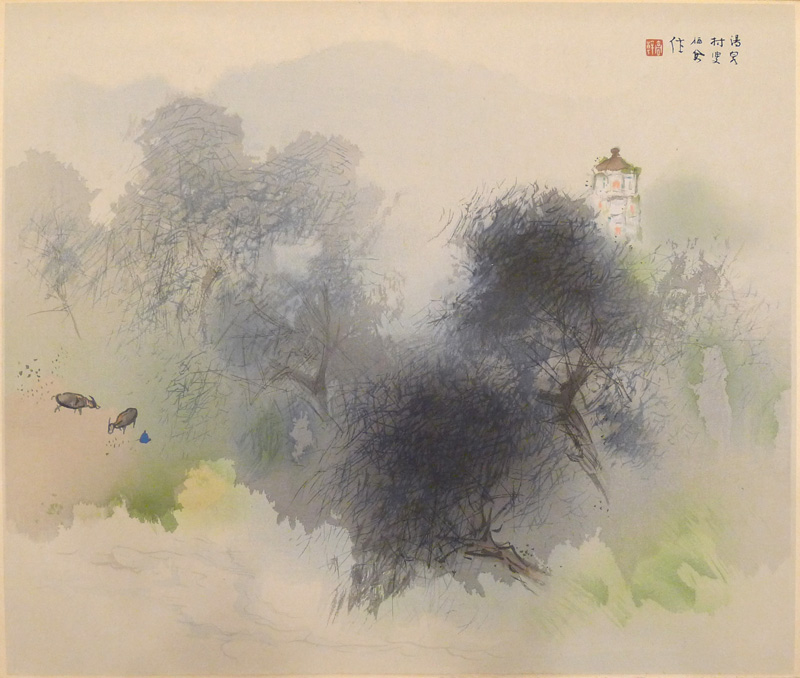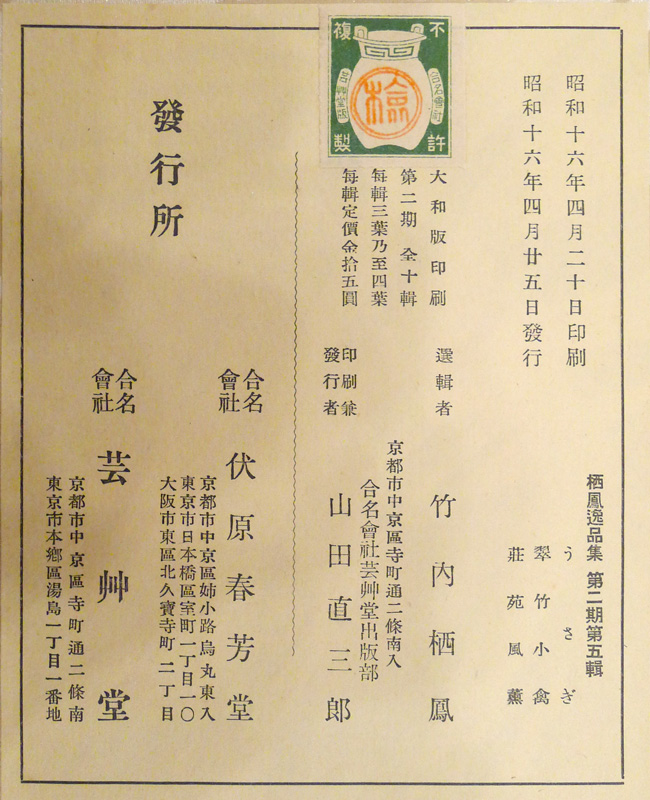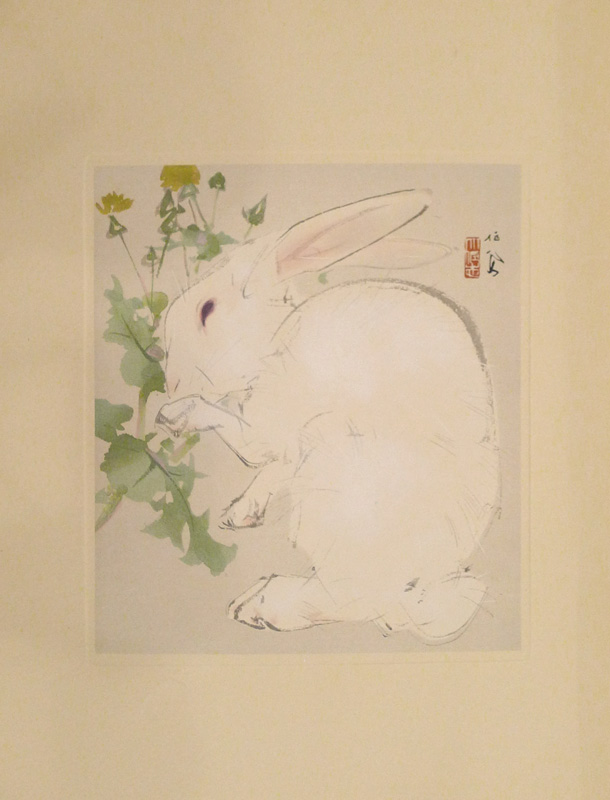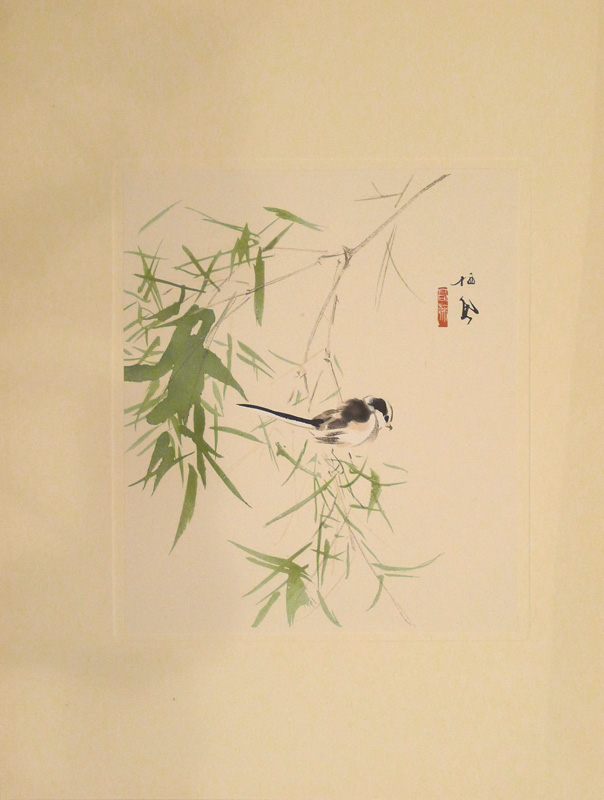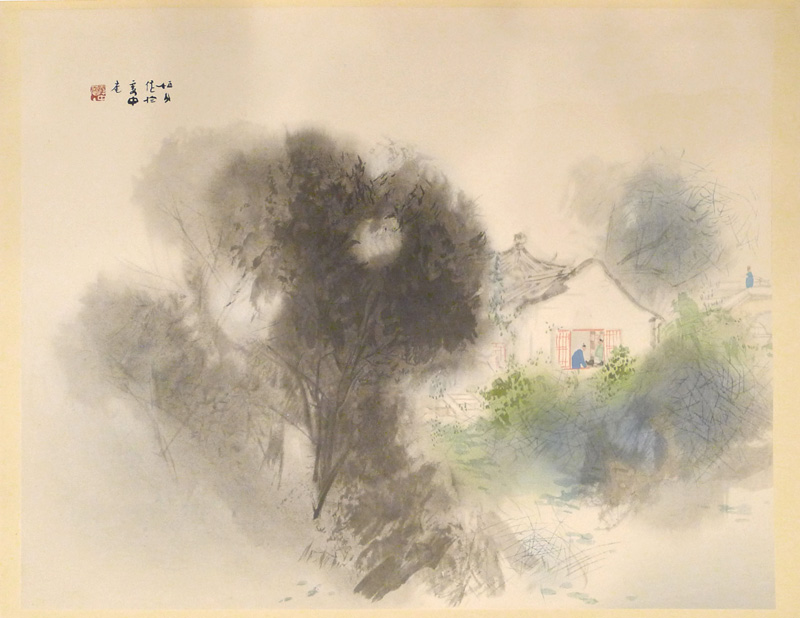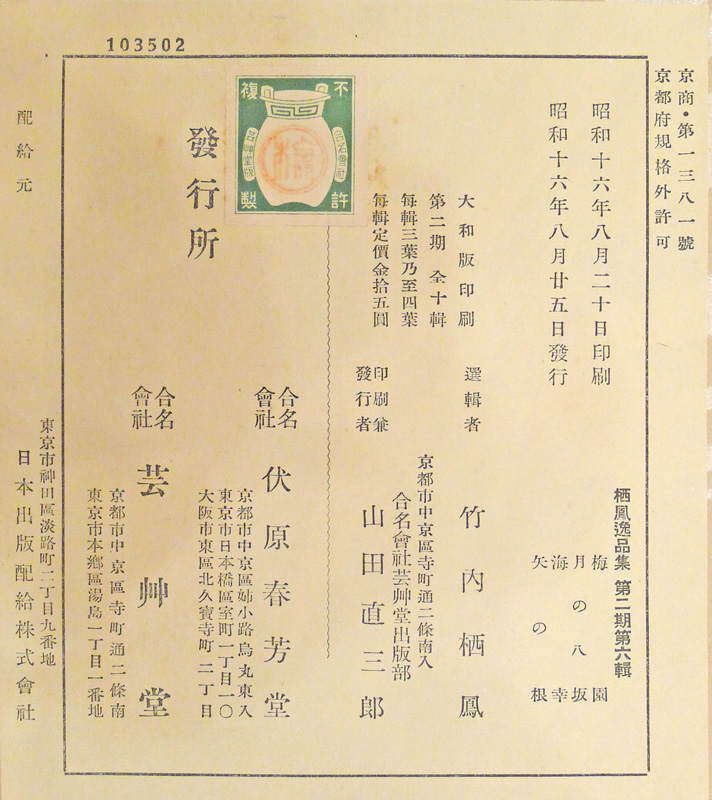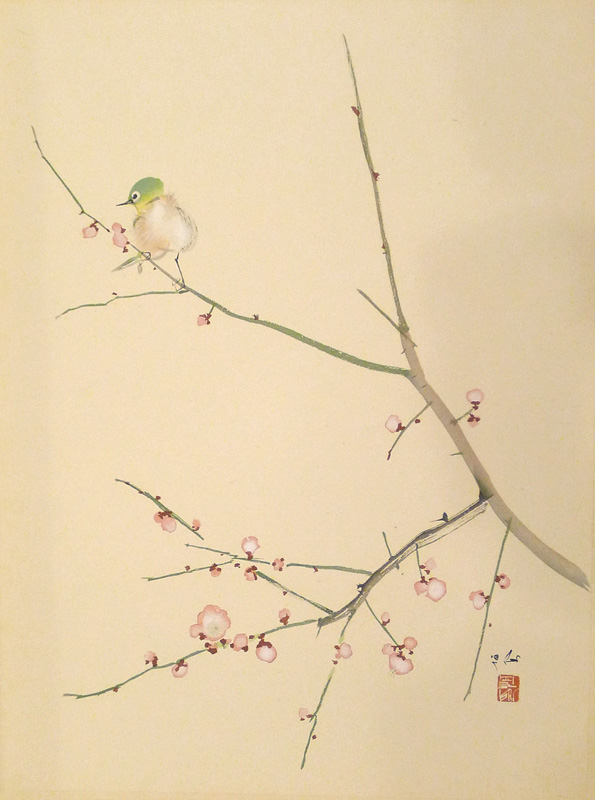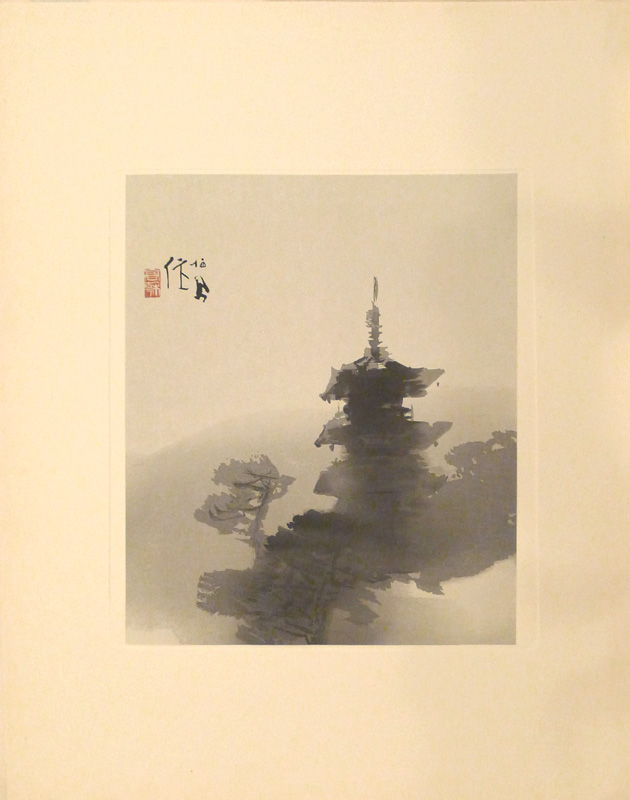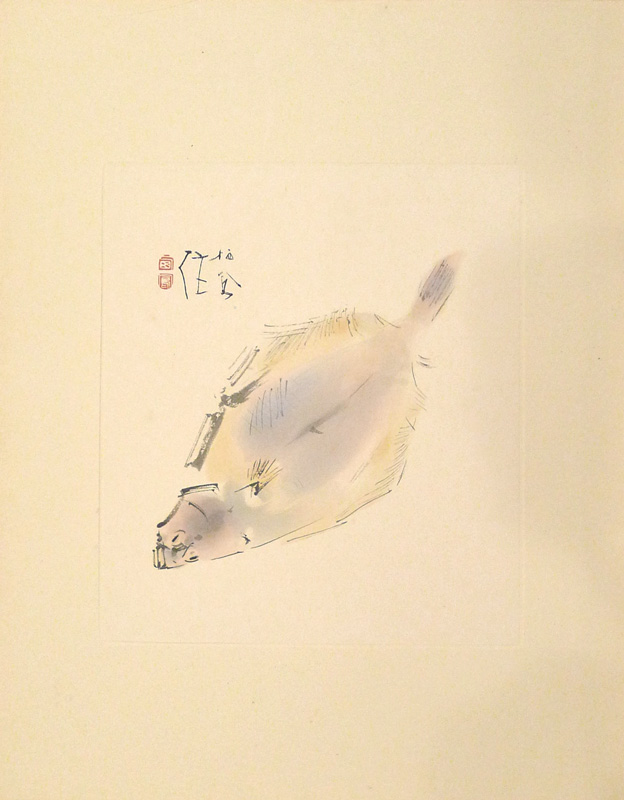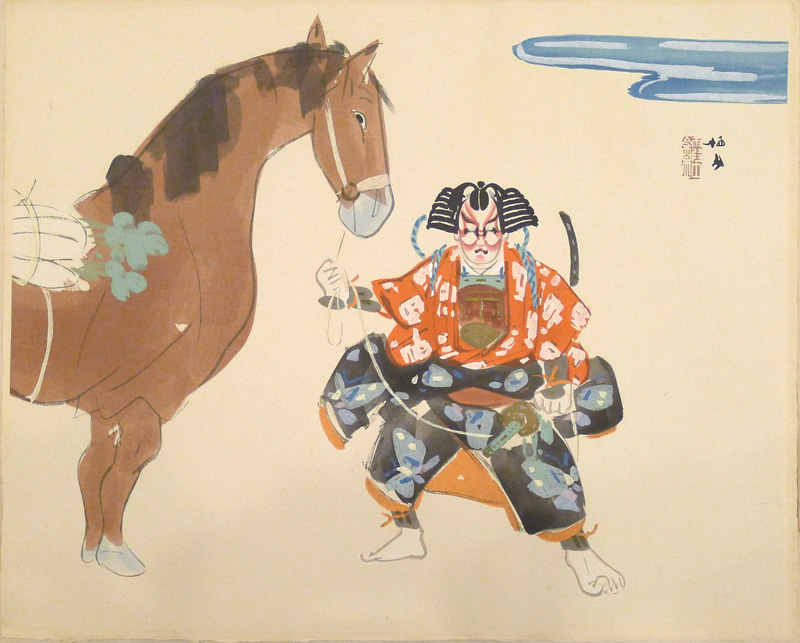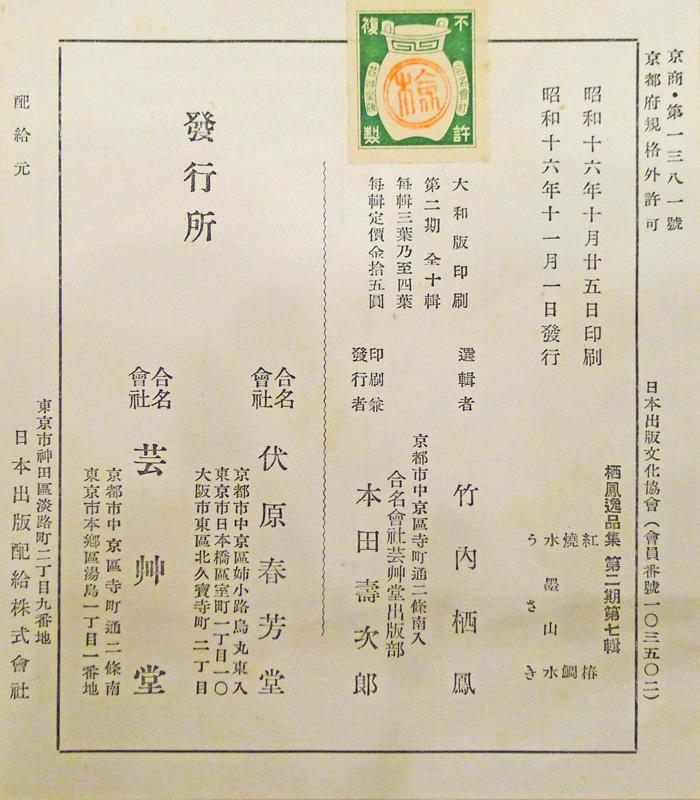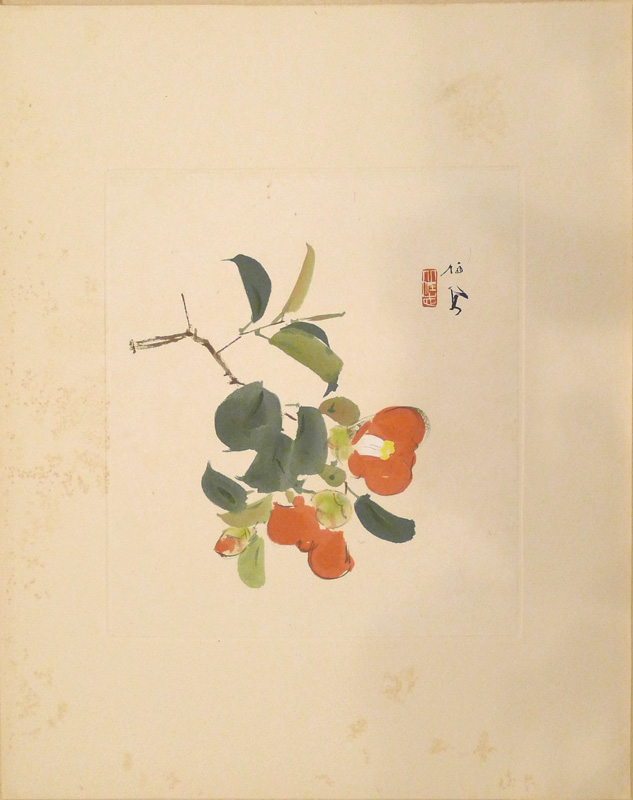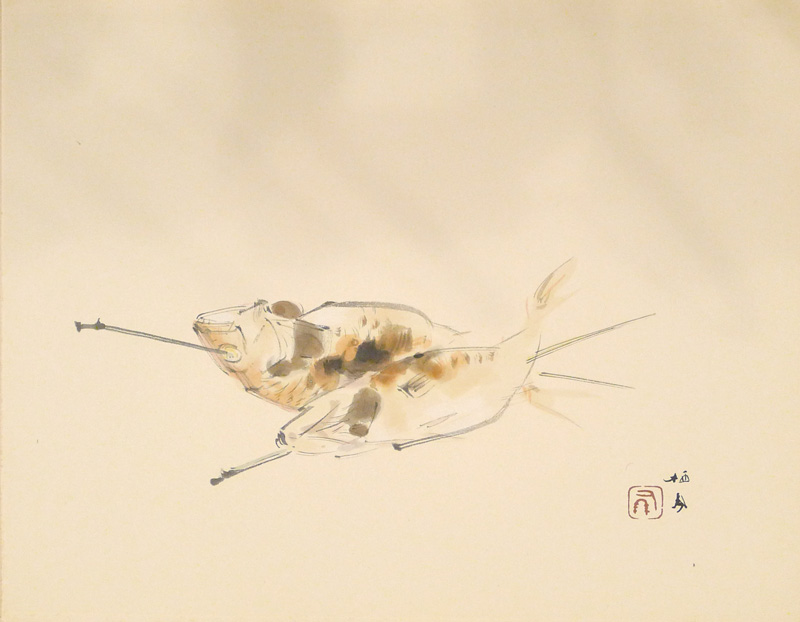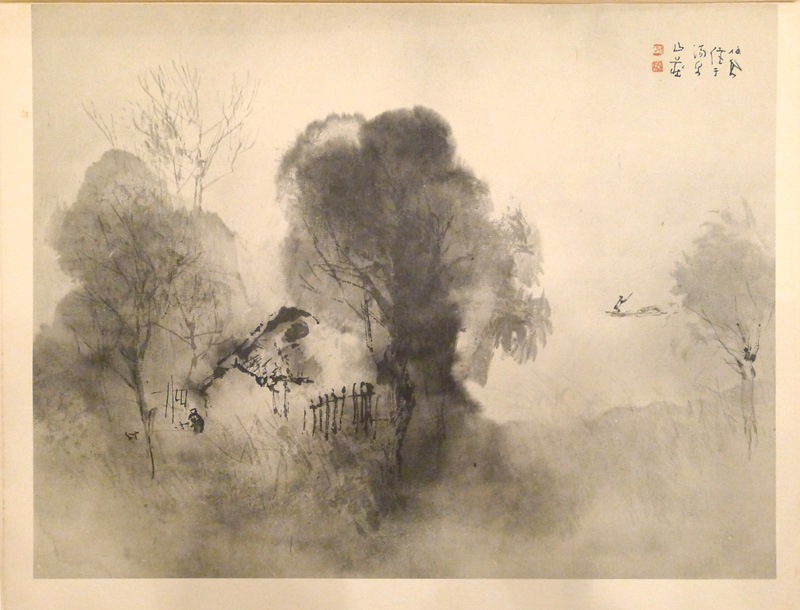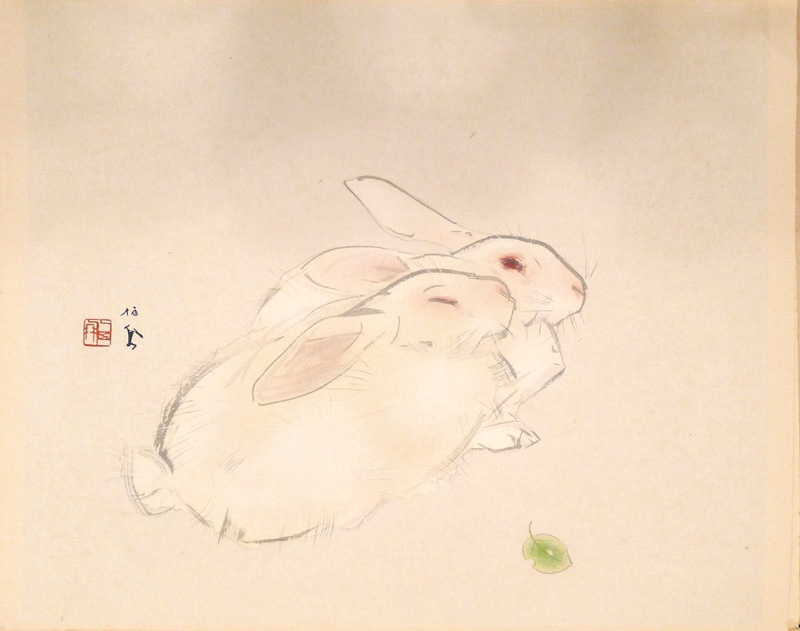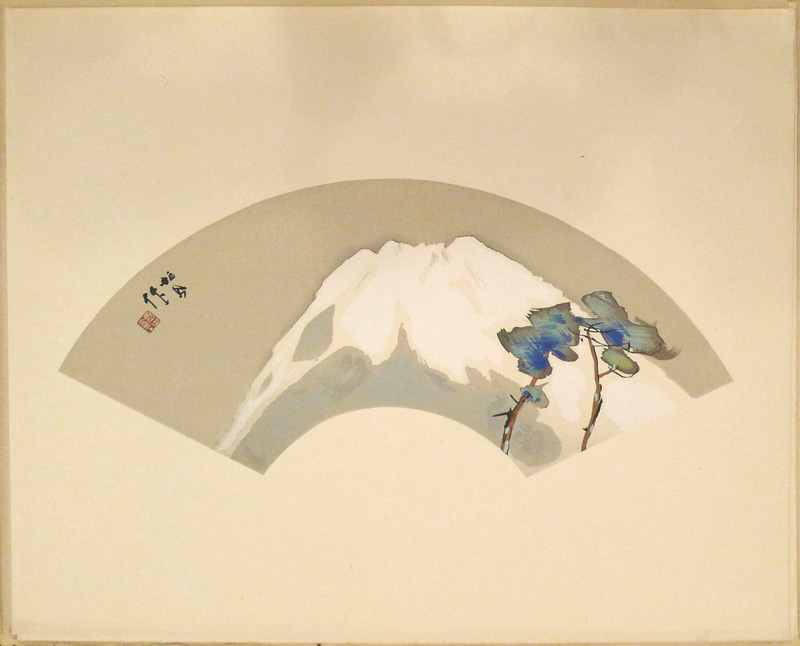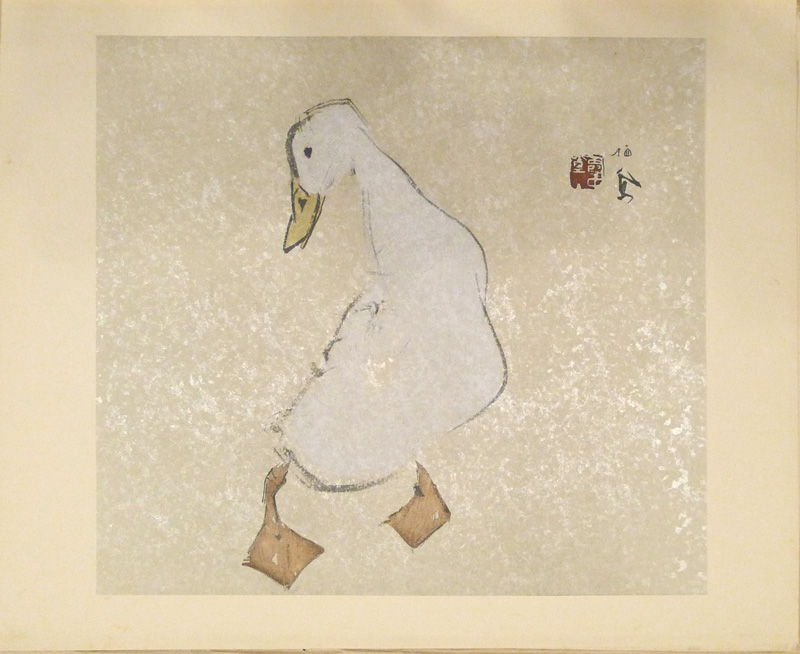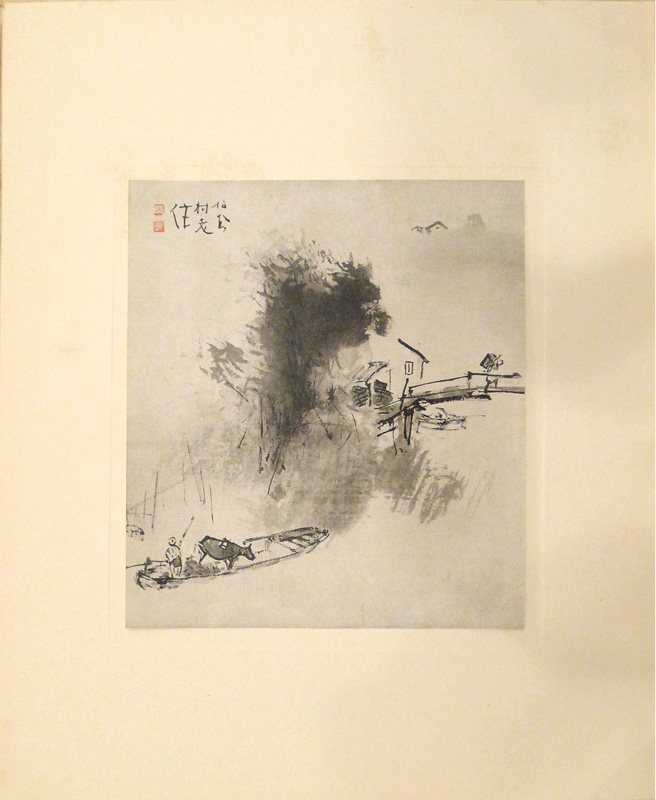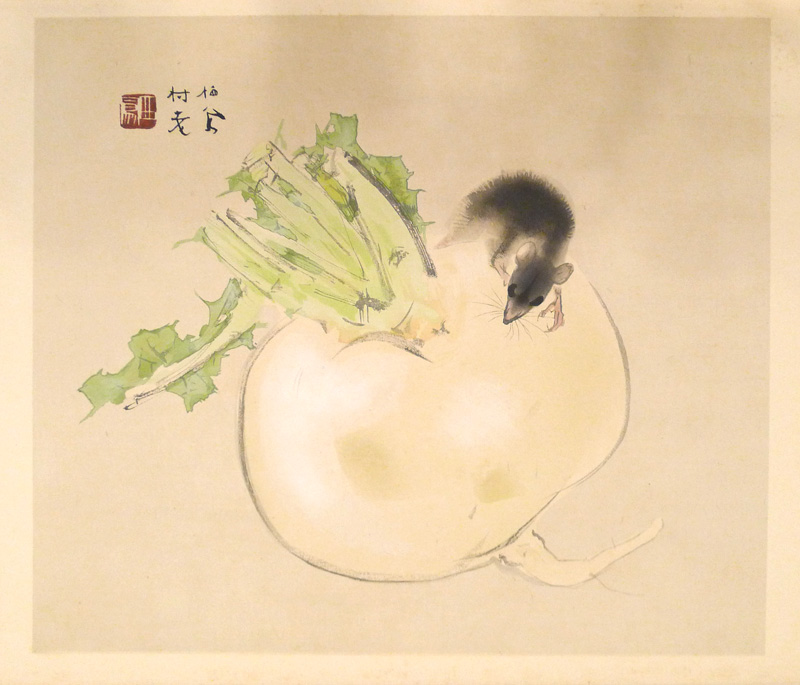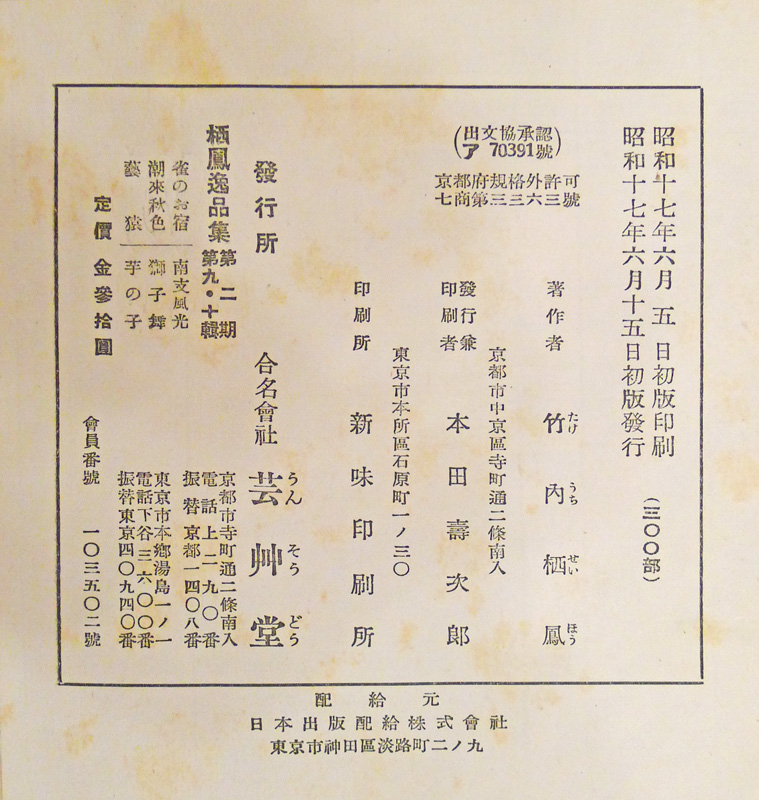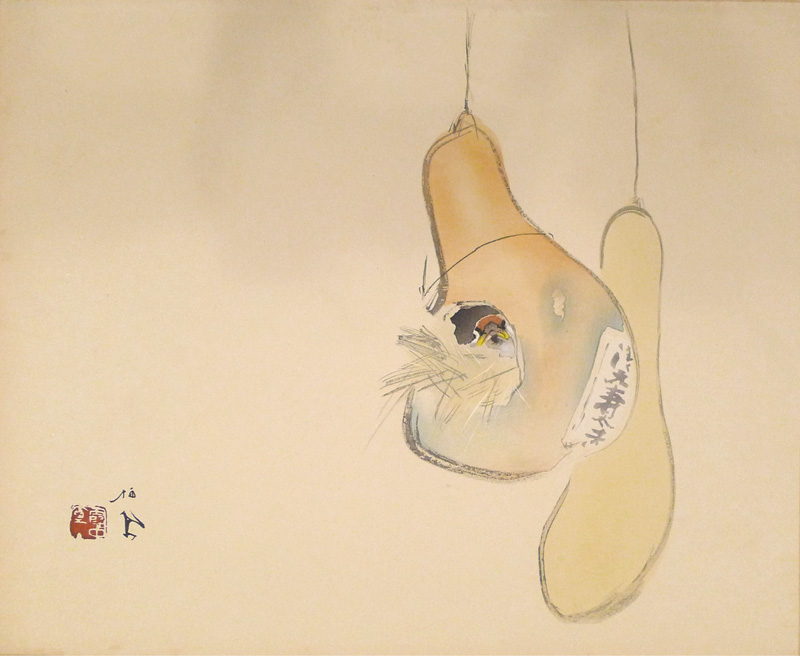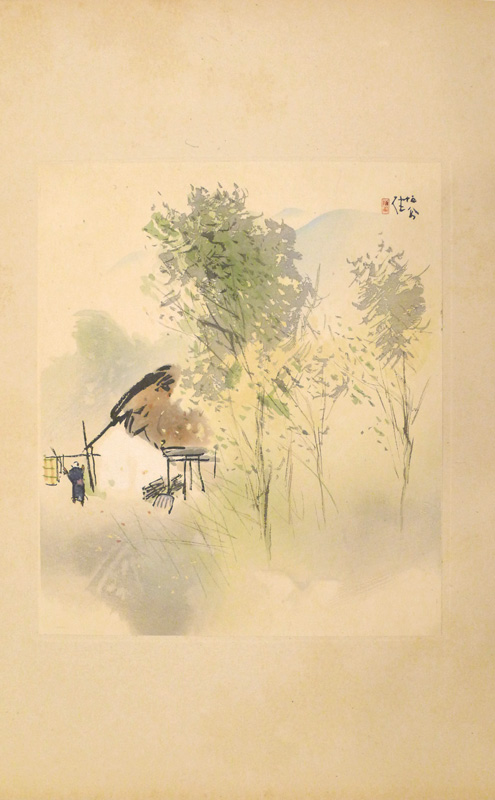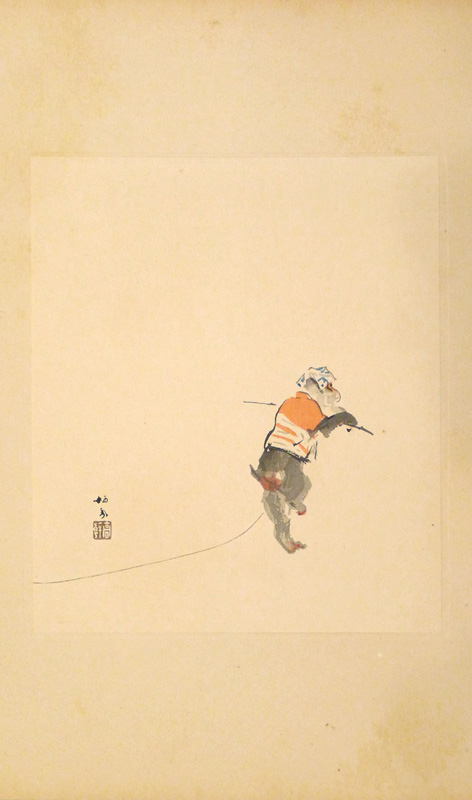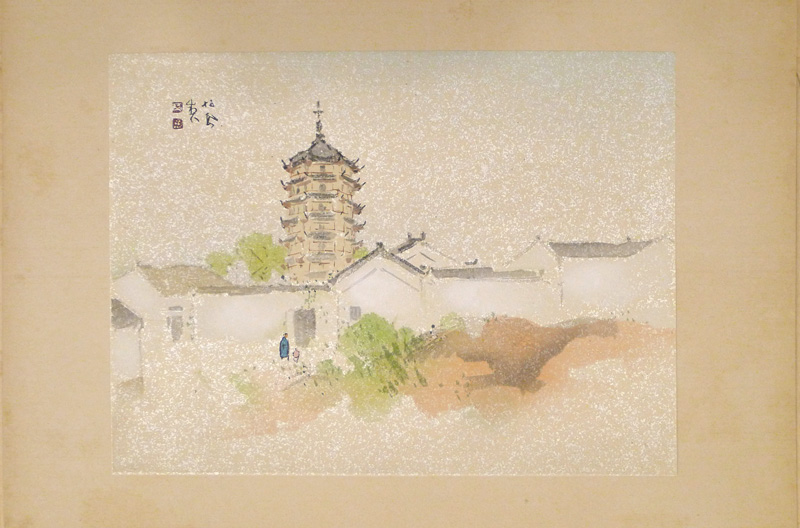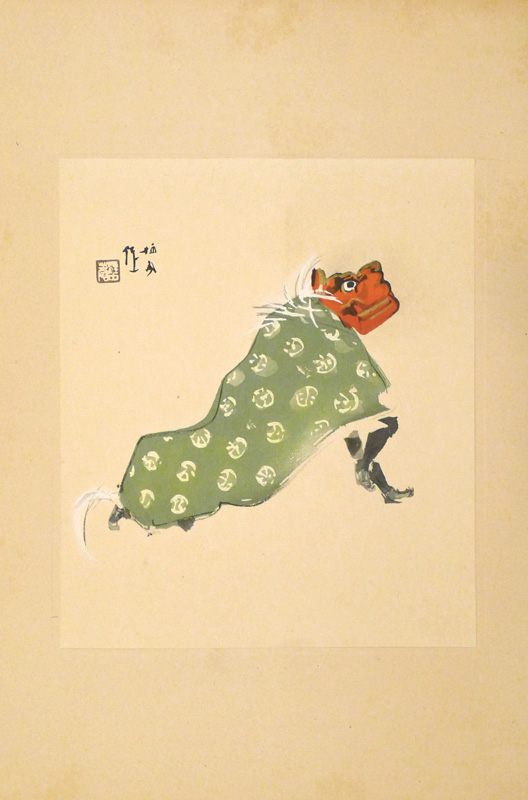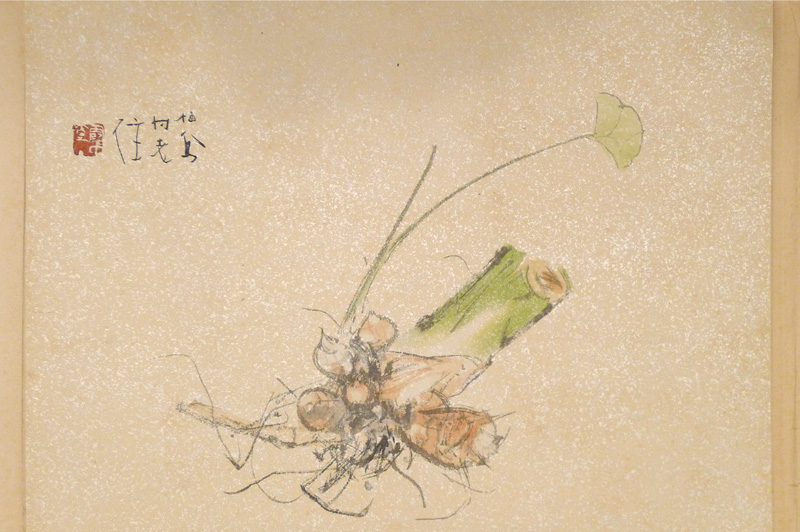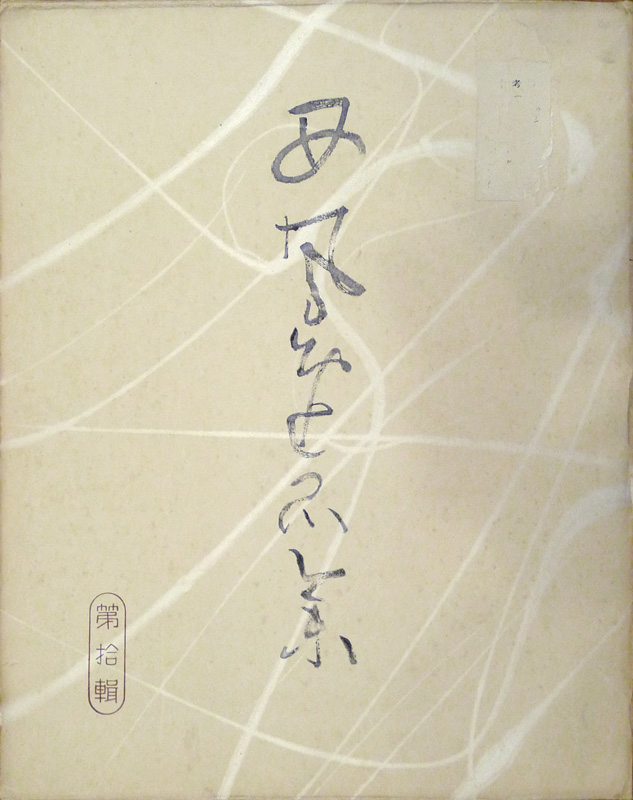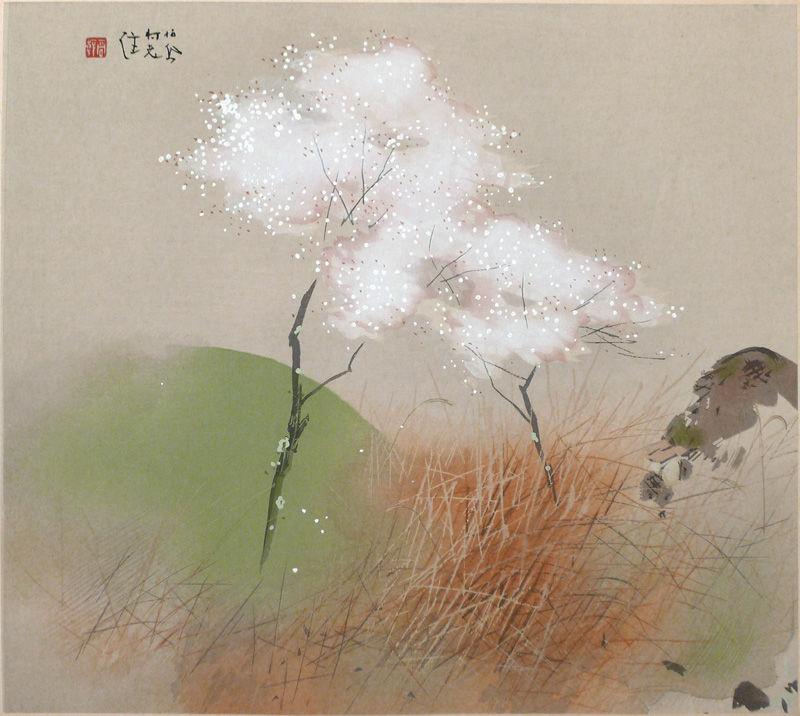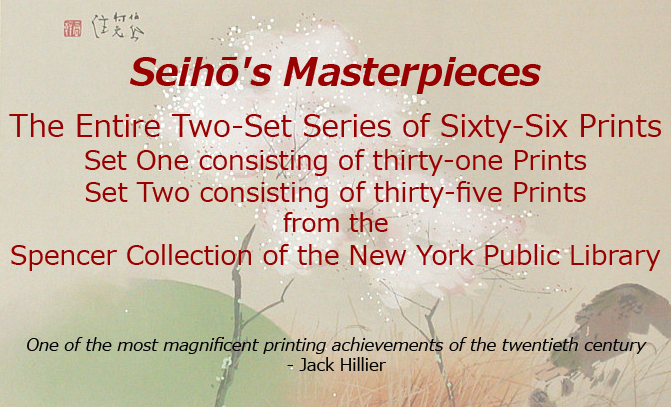
| Seihō's Masterpieces (栖鳳逸品集 Seihō's ippin shū) consists of sixty-six limited edition prints issued by Unsōdō Publishing over five years, beginning in April 1937 and ending in June 1942, produced from drawings made by the Kyoto artist Takeuchi Seihō (1864-1942). Using multiple printing techniques such as color woodblock and collotype, Unsōdō spared no effort in faithfully rendering into large-format prints Seihō’s watercolor and ink drawings.1 Seiho's Masterpieces includes scenes from the artist's travels to South China in 1921-1922, renderings of animals (domestic and wild), still-lifes of fish and flora, depictions of cultural events such as festival floats and kabuki, and landscapes of the Japanese countryside, including two prints depicting Mt. Fuji. While there are no historical records explaining how this project came about2, other than the 1937 Preface to Set One and the 1940 Publisher's Foreword to Set Two, it is reasonable to assume, given the artist’s declining health when the series was started in 1937 and his receipt of the Order of Culture in early 1937, that it was truly intended by his long-time publisher Unsōdō (and likely the artist himself) as an “elegy and a testament” to one of the greatest painters and teachers of his time.3 Displayed below are images of all sixty-six prints, part of the Spencer Collection of the New York Public Library, along with their titles and dimensions.4 Prints that are also part of this collection carry their catalogue number below their image. To my knowledge, this is the first time images of all the prints from Seihō's Masterpieces have been presented. Following the images of the prints additional details on the series are provided. 1 As the original drawings have been lost or destroyed we can only infer from the prints which media were used by Seihō to create the original drawings. 2 Any existing documentation was lost when the publisher’s Tokyo office, where the prints were made, was bombed and destroyed during WWII. 3 Ehon: The Artist and the Book in Japan, Roger S. Keyes, The University of Washington Press with the New York Public Library, December 2006, p. 252 (text reproduced below.) 4 All dimensions are of the print's paper size not including the backing sheet. |
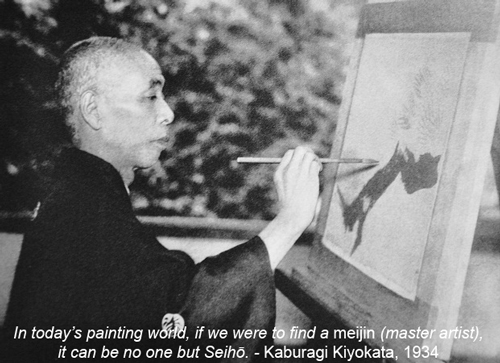
Colophon for Envelope 1 of Set One
| Envelope 1 Issued April 20, 1937 海魚 (ぐぢ) kaigyo Ocean Fish (tilefish) 14 1/2 x 18 7/8 in. (36.8 x 47.9 cm) | Envelope 1 Issued April 20, 1937 惜春 sekishun Spring is Over 14 1/8 x 4 5/8 in. (35.9 x 11.7 cm) IHL Cat. #897 | Envelope 1 Issued April 20, 1937 水墨雨後 Ink Painting, After the Rain 12 1/2 x 15 5/8 in. (31.8 x 32.1 cm) IHL Cat. #916 |
Date of printing reads Showa 12 (1937), 7th month, 15th day
Envelope 2 Issued July 25, 1937 紅富士 Pink Fuji 14 1/4 x 16 1/8 in. (36.2 x 41 cm) | Envelope 2 Issued July 25, 1937 水風清 Wind and Clear Water 10 x 10 5/8 in. (25.4 x 27 cm) IHL Cat. #874 | Envelope 2 Issued July 25, 1937 眠鷺 Sleeping Heron 15 3/8 x 5 3/8 in. (39.1 x 13.7 cm) |
Issued July 25, 1937
Date of printing reads Showa 12 (1937), 8th month, 19th day
Envelope 3 Issued August 25, 1937 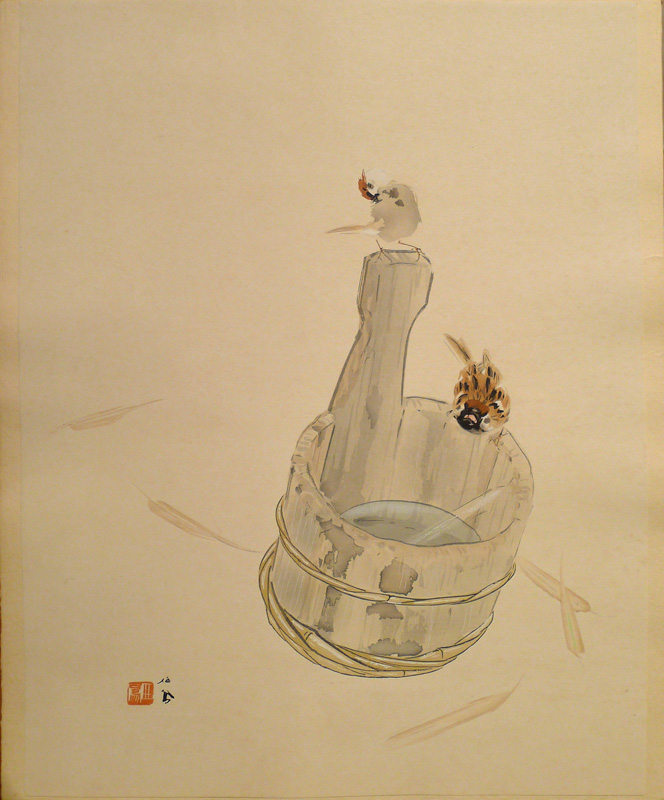 たまり水 mizutamari Puddle 18 3/4 x 14 1/4 in. (47.6 x 36.2 cm) | Envelope 3 Issued August 25, 1937 滿林秋色 shusshoku Woods in Full Autumn Color 14 1/4 x 15 1/2 in. (36.2 x 39.4 cm) | Envelope 3 Issued August 25, 1937 平潮 Slack Tide 10 5/8 x 14 1/4 in. (27 x 36.2 cm ) IHL Cat. #876 |
Colophon for Envelope 4 of Set One
Date of printing reads Showa 12 (1937), 12th month, 1st day
Envelope 4 Issued December 5, 1937 しぶ柿 shibugaki Dried Persimmons 14 3/16 x 4 3/4 in. (36 x 12.1 cm) | Envelope 4 Issued December 5, 1937 水郷 Beautiful Riverside Village IHL Cat. #815 15 x 18 5/8 in. (38.1 x 47.3 cm) | Envelope 4 Issued December 5, 1937 蟠蛇 Coiled Serpant |
Date of printing reads Showa 13 (1938), 2nd month, 15th day
| Envelope 5 Issued February 20, 1938 水風清 (部分) Wind and Clear Water (detail) 10 1/2 x 14 5/8 in. (26.7 x 34.1 cm) IHL Cat. #875 | Envelope 5 Issued February 20, 1938 夏霞 Summer Haze 11 1/4 x 16 1/8 in. (36.2 x 41 cm) | Envelope 5 Issued February 20, 1938 椿 tsubaki Camellia 15 1/16 x 18 1/2 in. (38.3 x 47 cm) |
Date of printing reads Showa 13 (1938), 3rd month, 20th day
| Envelope 6 Issued March 25, 1938 鮮魚 (鯖) senyo saba Fresh Fish (mackerel) 14 1/8 x 15 5/8 in. (35.9 x 39.7 cm) IHL Cat.#918 | Envelope 6 Issued March 25, 1938 南支風光 South China Scenery 11 3/16 x 16 1/8 in. (28.4 x 41 cm) | Envelope 6 Issued March 25, 1938 浪花舞燕 Swallowflitting above the waves 13 7/16 x 16 1/4 in. (13.4 x 41.3 cm) |
Colophon for Envelope 7 of Set One
Date of printing reads Showa 13 (1938), 4th month, 15th day
| Envelope 7 Issued April 20, 1938 武惡 Evil Warrior 15 3/16 x 13 1/2 in. (38.6 x 34.3 cm) | Envelope 7 Issued April 20, 1938 水墨山水 suiboku sansui Ink Painting, Landscape 12 5/8 x 14 9/16 in. (32.1 x 37 cm) | Envelope 7 Issued April 20, 1938 家鴨 ahiru Domestic Duck 15 x 18 1/2 in. (38.1 x 47 cm) |
Colophon for Envelope 8 of Set One
Date of issue reads Showa 13 (1938), 7th month, 25th day
Date of printing reads Showa 13 (1938), 7th month, 20th day
| Envelope 8 Issued July 25, 1938 秋興 shūkyō The Pleasantness of Autumn 14 7/8 x 18 3/4 in. (37.8 x 47.6 cm) | Envelope 8 Issued July 25, 1938 13 15/16 x 18 3/16 (35.4 x 46.2 cm) | Envelope 8 Issued July 25, 1938 黃初平 Wong Cho Ping 15 x 16 7/8 in. (38.1 x 42.9 cm) IHL Cat. #913 |
Colophon for Envelope 9 of Set One
Date of issue reads Showa 13 (1938), 11th month, 10th day
Date of printing reads Showa 13 (1938), 11th month, 5th day
| Envelope 9 Issued November 10, 1938 梅雨時 tsuyudoki Rainy Season 15 1/8 x 17 1/2 in. (38.4 x 44.5 cm) | Envelope 9 Issued November 10, 1938 雄姿颯爽 yūshi sassō Gallant and Dashing 18 7/8 x 15 1/8 in. (47.9 x 38.4 cm) | Envelope 9 Issued November 10, 1938 枯木吟猿 Singing Monkey on a Bare Tree 15 x 18 3/16 in. (38.1 x 46.7 cm) IHL Cat. #915 |
Colophon for Envelope 10 of Set One
Date of issue reads Showa 13 (1938), 12th month, 15th day
Date of printing reads Showa 13 (1938), 11th month, 20th day
| Envelope 10 Issued December 12, 1938 狗子 Puppy 15 3/16 x 18 5/8 in. (38.6 x 47.3 cm) IHL Cat. #914 | Envelope 10 Issued December 12, 1938 祇園祭 Gionmatsuri Gion Festival 10 x 14 3/8 in. (25.4 x 36.5 cm) | Envelope 10 Issued December 12, 1938 水墨山水 suiboku sansui Ink Painting, Landscape 13 3/4 x 13 3/8 in. (34.9 x 34 cm) |
| Envelope 1 Issued January 1940 | Envelope 1 Issued January 1940 Publisher's Foreword [dated Kigen 2600 (2600th year of the Imperial Era)] | Envelope 1 Issued January 1940 Table of Contents Series 2 |
| Envelope 1 Issued January 1940西郊 seikou Fields in Springtime 15 5/16 x 17 11/16 (38.9 x 44.9 cm) | Envelope 1 Issued January 1940 溪村晩霽 ClearNight in Tanimura 12 1/4 x 11 3/8 in. (31.1 x 28.9 cm) | Envelope 1 Issued January 1940 じろ柿 shiro kaki Dried (white) Persimmon 10 15/16 x 9 11/16 (27.8 x 24.6 cm) IHL Cat. #908 |
Issued January 1940
Colophon for Envelope 2 of Set Two
Date of issue reads Showa 15 (1940), 4th month, 25th day
Date of printing reads Showa 15 (1940), 4th month, 20th day
| Envelope 2 Issued April 25, 1940 山村の花 sanson no hana Mountain Village Flowers 15 1/8 x 16 7/8 in. (38.4 x 42.9 cm) | Envelope 2 Issued April 25, 1940 冬日村居 Winter Day in the Village 13 x 14 7/8 in. (33 x 37.8 cm) IHL Cat. #911 | Envelope 2 Issued April 25, 1940釜ほい山 Kama-hori, Yama (float) 15 x 18 3/4 in. (38.1 x 47.6 cm) |
Colophon for Envelope 3 of Set Two
Date of issue reads Showa 15 (1940), 9th month, 20th day
Date of printing reads Showa 15 (1940), 9th month, 15th day
| Envelope 3 Issued September 20, 1940 江南風色 River Breeze 18 1/4 x 10 11/16 in. (26 x 27.1 cm ) IHL Cat. #843 | Envelope 3 Issued September 20, 1940 旅窗漫筆 Sketchesfrom a Window while Traveling 18 9/16 x 14 3/8 in. (47.1 x 36.5 cm) IHL Cat. #912 | Envelope 3 Issued September 20, 1940 殘夢 Remnantof a Dream 15 1/4 x 18 3/4 in. (38.7 x 47.6 cm) |
Colophon for Envelope 4 of Set Two
Date of issue reads Showa 16 (1941), 1st month, 5th day
Date of printing reads Showa 15 (1940), 12th month, 30th day
Colophon for Envelope 5 of Set Two
Date of issue reads Showa 16 (1941), 4th month, 25th day
Date of printing reads Showa 16 (1941), 4th month, 20th day
| Envelope 5 Issued April 25, 1941 うさぎ usagi Rabbit 10 3/4 x 9 5/8 in.(27.3 x 24.4 cm) | Envelope 5 Issued April 25, 1941 翠竹小禽 Green Bamboo and Small Bird 10 13/16 x 9 1/2 in. (27.5 x 24.1 cm) | Envelope 5 Issued April 25, 1941 莊苑風薫 kunpū shōen Summer Breeze through the Manor 14 1/2 x 17 5/8 in. (36.8 x 44.8 cm) |
Colophon for Envelope 6 of Set Two
Date of issue reads Showa 16 (1941), 8th month, 25th day
Date of printing reads Showa 16 (1941), 8th month, 20th day
| Envelope 6 Issued August 25, 1941 梅園 baien Plum Garden 18 5/8 x 14 7/8 in. (47.3 x 37.8 cm) | Envelope 6 Issued August 25, 1941 月の八坂 Yasaka Pagoda in Moonlight 11 1/16 x 9 1/8 in. (28.1 x 23.2 cm) | Envelope 6 Issued August 25, 1941 海幸 Fruit of the Sea 14 x 9 15/16 in. (35.6 x 25.2 cm) IHL Cat. #917 |
Colophon for Envelope 7 of Set Two
Date of issue reads Showa 16 (1941), 11th month, 1st day
Date of printing reads Showa 16 (1941), 10th month, 25th day
| Envelope 7 Issued November 1, 1941 紅椿 CrimsonCamellia 11 x 9 15/16 in. (27.9 x 25.2 cm) | Envelope 7 Issued November 1, 1941 燒鯛 Grilled Sea Bream 15 x 18 3/4 in. (38.1 x 47.6 cm) IHL Cat. #910 | Envelope 7 Issued November 1, 1941 水墨山水 suiboku sansui Ink Painting, Landscape 13 3/4 x 17 9/16 in. (34.9 x 44.6 cm) |
Envelope 7
Issued November 1, 1941
うさぎ
usagi
Rabbits
Colophon for Envelope 8 of Set Two
Date of issue reads Showa 17 (1942), 6th month, 15th day
Date of printing reads Showa 17 (1942), 6th month, 5th day
| Envelope 8 Issued June 15, 1942 富嶽 fugaku Mt. Fuji 15 x 18 3/4 in. (38.1 x 47.6 cm) | Envelope 8 Issued June 15, 1942 家鴨 ahiru Domestic Duck 13 1/4 x 14 7/16 in. (33.7 x 36.7 cm) | Envelope 8 Issued June 15, 1942 潮來 Itako 10 7/16 x 9 3/16 in. (26.5 x 23.3 cm) |
Colophon for Envelope 9 of Set Two
Date of printing reads Showa 17 (1942), 6th month, 5th day
| Envelope 9 Issued June 15, 1942 | Envelope 9 Issued June 15, 1942 潮來秋色 Autumn Scenery in Itako 11 x 9 5/8 in. (27.9 x 24.4 cm) | Envelope 9 Issued June 15, 1942 藝猿 Performing Monkey 11 x 9 5/8 in. (27.9 x 24.4 cm) |
| Envelope 9 Issued June 15, 1942 南支風光 nanshi fūkō South China Scenery 10 1/8 x 13 3/8 in. (25.7 x 34 cm) | Envelope 9 Issued June 15, 1942 獅子舞 shishimai Lion Dance 11 x 9 5/8 in. (27.9 x 24.4 cm) | Envelope 9 Issued June 15, 1942 芋の子 Imonoko Minor Taro Root 15 1/4 x 19 1/8 in. (38.7 x 48.6 cm) |
The Series "Seihō's Masterpieces"
Set One of the series consists of thirty-one prints issued between April 1937 and December 1938. The first four prints of Set Two, consisting of thirty-five prints, were issued in January 1940 and the final prints were issued on June 15, 1942, shortly before Seihō's death in August of that year. The prints in both sets were released in groups of three, four, or, in one case, six prints, with each print mounted on a stiff piece of paper and covered with a glassine sheet. Each group was then placed into a mica-decorated envelope that included a colophon listing the date of publication and the titles of the prints in the envelope.A preface by the publisher to the series was issued in April 1937 with the first group of three prints in Set One and was re-issued in January 1940 with the first group of four prints from Set Two. On their web page for volume 1 of Seihō ippin shū 栖鳳逸品集, FSC-GR-780.595.1-35, the Smithsonian provides a copy of a hand-written translation of the preface, which I've transcribed below.
The painter Takeuchi Seiho is an eminent master of the present Nihonga circle with his refined brushwork and matured techniques. His recent works have gained more brilliance and [are] acquired and stored (by collectors) immediately after the completion without having been exposed to praises of the world. It is very pity [sic] that there is hardly any chance to see his art work once it [is] stored by a collector. We had an idea, therefore, to ask the artist to select a master work, publish[ed] one by one so that we can meet the desire of the world.
Fortunately the artist accepted our proposal immediately and even offered and promised to select works exclusively for this publication. We were very happy to hear that. Therefore we tried our best to print with our most refined technique and to convey the spirit and fine taste of the original painting. (Through these) we hoped a viewer can have the best possibility to enjoy them. We are very happy if they meet your expectation and receive your praisal [sic].
Showa 12. Rabbit month (1937)
The Master of the Unsō-dō
The title for each print is provided in three places: affixed to the back of the paper the print was originally tipped to, on the colophons attached to each envelope the prints were released in, and in the Table of Contents that accompanied each of the two sets. Note that I have not seen a table of contents for Set One2, though it likely exists somewhere since Keyes states that a table of contents for Set One was released in April 1937.3
The size of the original edition for both sets was likely between 100 and 300 copies.4 While both Hillier and Keyes state that only a single edition of the series was made (based on Unsōdō's reports that the blocks were destroyed when their Tokyo facility was bombed during WWII), at least six of the prints were reissued by Unsōdō after Seihō's death, as square format (shikishiban) prints mounted on decorative cardboard. Yanaka Pagoda in Moonlight in this collection is one of the reissued prints; and other Unsōdō reissues include Early Summer, Narcissus, Green Bamboo and Small Bird, Puppy and Crimson Camellia. Given Hillier's and Keyes' assertions, I have to assume that the re-issued prints were made from newly cut blocks.
The majority of the prints were produced using traditional woodblock techniques, but collotype (yamato-ban insatsu)5 , a photographic process, was used for seven prints in Set One, which reproduce existing paintings by the artist. Hillier restates Unsōdō's assertion that "Seihō himself supervised the printing, which was carried out by one master printer."6 Keyes identifies that printer as Shinmi Saburō 新味 三朗7, Unsōdō's primary printer for many years.
1 Kigen 2600 references the 2600th year of the Imperial Era (1940 AD) and was an occasion for great nationalist displays in wartime Japan.
2 A table of contents for Set One was not present in the New York Public Library's Spencer Collection when I viewed it in 2012 and 2013.
3 Ehon: The Artist and the Book in Japan, Roger S. Keyes, The University of Washington Press with New York Public Library, December 2006, p. 289.
4 Hillier in The Art of the Japanese Book, p. 993, deduces, based on the "normal practice" of the publisher Unsōdō, that no more than one hundred copies of the first ten parts were printed. Keyes, however, notes in the "Bibliographic Descriptions and References" section, p. 289, of Ehon: The Artist and the Book in Japan, "Edition of 300" and the last two colophons appearing on the envelopes for set two, state "三00部" (300 copies). At the time of his writing in 1987, Hillier did not find evidence that any of the second set of prints were ever produced. Of course we now know that the second set was issued and, in fact, is present in the New York Public Library's Spencer Collection.
5 Collotype printing had its first commercial use in Japan in 1889. The collotype process was versatile and could produce high quality images on different types of paper. Collotype prints can be readily identified by the presence of image reticulation, a product of the finely cracked gelatin plate used to print the image, which can be seen under magnification. The size of the reticulation varies from print to print, but cannot be seen by the naked eye. The image can be a variety of colors. Prints made from collotype plates can be either hand printed or printed using a press.
6 The Art of the Japanese Book, Jack Hillier, Sothebys Publications, London, 1987, p. 993.
7 Ehon: The Artist and the Book in Japan, Roger S. Keyes, The University of Washington Press with New York Public Library, December 2006, p. 252.
Seihō’s Masterworks - an elegy and a testament
I had the opportunity to view and photograph all sixty-six prints that make up the two sets of Seihō's Masterpieces in the New York Public Library's Print Room (part of their Spencer Collection1), and they are as impressive as Roger Keyes' comments, below, indicate.
In attempting to translate the titles of the prints into English (and all errors in translation are mine alone), I found it intriguing that many of the titles used uniquely Chinese characters, suggesting a rather cultured market for this series. I also enjoyed the rather allusive nature of some of the titles, such as 殘夢 (Remnant of a Dream), picturing a fox and a noblewoman's sedge hat. A Japanese friend suggested that perhaps the fox, which can take on human form in Japanese legend, is vaguely recalling her past form as a noblewoman - the presence of the sedge hat triggering that "fragment" or "remnant" of a vague memory of things past.
Source: Ehon: The Artist and the Book in Japan, Roger S. Keyes, The University of Washington Press with New York Public Library, December 2006, p. 252-253.
| Seihō’s Masterworks is both an elegy and a testament. Seihō was the great Kyoto painter of his generation: prodigiously gifted, boundlessly curious, fearless, open, astute, articulate. He personally chose the sixty-three representative pictures2 in the series and died in August 1942, a month after completing the set. Masterworks is also the culminating work of traditional Japanese collaborative printmaking. The cutters and printers broke new ground, adopting new technologies like collotype3, and devising new techniques to translate the subtle effects of Seihō’s paintings into effective color woodcuts. Inadvertently, Masterworks is also an elegy for nearly four hundred years of peace and for the art and beauty that flowed from it. When Tokugawa Ieyasu (1543-1616) became shogun after centuries of unrest, he devised an ingenious new system of government to preserve and safeguard peace. He expected it to last for ten thousand years, but the government collapsed soon after the opening of Japan to foreign trade in the 1850s, and brief civil wars were followed by successful military campaigns against China, Korea and Russia at the turn of the century. The 1930s were a decade of fear in Japan. Military factions used assassination and coups to intimidate civilian politicians, and secret police to control the population. Unsōdō published Seihō’s daring “Pink Fuji” in July 1937. "Pink Fuji" (Beni Fuji 紅富士), 1937 At certain times of the year the rising sun turns the slopes of Mt. Fuji pink. Katsushika Hokusai (1760-1849) captured this momentary effect in early impressions of one of his famous landscapes, and Seihō’s green hill echoes the green slope in Hokusai’s print.Set One, Envelope 2 click on image to enlarge Seihō and his cutter and printer all emphasized the brushwork of the dark blue shadow. This is probably another ephemeral effect of morning light, although it also feels strangely foreboding in retrospect, since the Imperial Army invaded China the month the print appeared, setting into inexorable motion the tragic events of the great war that produced nearly three million military and eight hundred thousand civilian casualties, five percent of the entire Japanese population, and left another thirteen million homeless. “The sadness of things” (mono no aware) is a phrase that Lady Murasaki often used in The Tale of Genji (ca. 1000). Cherry blossoms in full bloom often arouse feelings of sorrow because their beauty is so short-lived: they are “beautiful because they fall,” like young warriors in the flower of their youth who die in battle. Seihō was seventy-six when he drew “Flowers in a Mountain Village” (1940, fig. 65.3). “This moment,” he seems to be saying, “This moment!” "Flowers in a Mountain Village" (山村の花 Yamamura no hana), 1940 Set Two, Print 5 click on image to enlarge The words ippin in the [series] title has recently come to mean “masterworks.” In China, the same characters, pronounced yi pin, originally meant “untrammeled freedom” and were applied in the highest praise to exceptional painters. In Japan by the eighteenth century the word had come to suggest painting of deep feeling that looked uncontrived and spontaneous and employed soft washes, delicate gradations of color, and virtuoso brushwork. So another translation of the title might by The Sublime Work of Seihō. Jack Hillier called this book “one of the most magnificent printing achievements of the twentieth century.” It is also one of the rarest.4 The incendiary raids on Japanese cities in the spring of 1945 burned the printer Shinmi Saburō’s Tokyo studio and destroyed all the blocks for Masterworks. Most of the printed examples must have burned as well. The Chiba City Museum owns a bound set of the first series, but this example of the second series may be unique. Hillier thought it was never published. Unsōdō has no records of the publication and no example on file. |
http://www.nypl.org/locations/schwarzman/prints-and-photographs-study-room/spencer-collection
2 While Keyes references "sixty-three representative pictures," a total of sixty-six prints were issued in the two sets of Seihō's Masterpieces.
4 Hillier in The Art of the Japanese Book, p. 993, deduces, based on the "normal practice" of the publisher Unsōdō, that no more than one hundred copies of the first ten parts were printed. Nor does he find evidence that any of the "announced" second set of ten parts were ever produced. Of course, we now know that the second set was issued and, in fact, resides in the New York Public Library's Spencer Collection and the collection of Amsterdam's Rijksmuseum. The Rijksmuseum lists 60 prints in their collection, with 29 bound into one volume (RP-P-2005-614) and 31 into a second volume (RP-P-2005-615). They go on to note "the prints mounted in the two albums are not in order of the original date of issue." The Rijksmuseum also lists another album, RP-P-2001-21, containing prints from the series. It is described as: "32 sheets: first sheet, introduction; 31 prints of Takeuchi Seiho; in dark blue cover with title." This description suggests it is an album comprised of the 31 prints and preface that comprise Set One.
last revision:
